#this is actually surreal to me. like.. its public knowledge that this movie was filmed in 2020 during social distancing
Explore tagged Tumblr posts
Text
i think Long Distance actually finally coming out was the universe kind of making up for the other bullshit it put me through this year. just in time for christmas <3
#this is actually surreal to me. like.. its public knowledge that this movie was filmed in 2020 during social distancing#bc thats the only news it ever got before silence and release dates that got pushed year after year#and that whole time i couldnt say anything. because there was not even a trailer to share. not even a poster#and keep in mind the whole time im like “this was some of the MOST fun ive ever had working on something in my career”#and desperately waiting for the day i can proudly display my work in my portfolio....#and then it had an unusual foreign release under the radar???? and still months of no news of a domestic release?????#STILL no marketing?????????#and then suddenly its just out#like OH OKAY???#IM POPPING CHAMPAAAAAAAAAAAAAAAIGN!!!!!!!!!!!!!!!!!!!!!!!!!!!#im not. but metaphorically#i told EVERYONE today#i was SO fucking excited#like alright let me do your marketing for you then#im gonna watch it this weekend with friends.. omg finally seeing the whole thing.. finally hearing the music and sound effects...#jennilargh
11 notes
·
View notes
Text
Fifteen Days of Disney Magic - Number 6
Welcome to Fifteen Days of Disney Magic! In honor of the company’s 100th Anniversary, I am counting down my Top 15 Favorite Movies from Walt Disney Animation Studios! To introduce today’s entry, I have only this to say: “Most Everyone’s Mad Here.” Number 6 is…Alice in Wonderland.
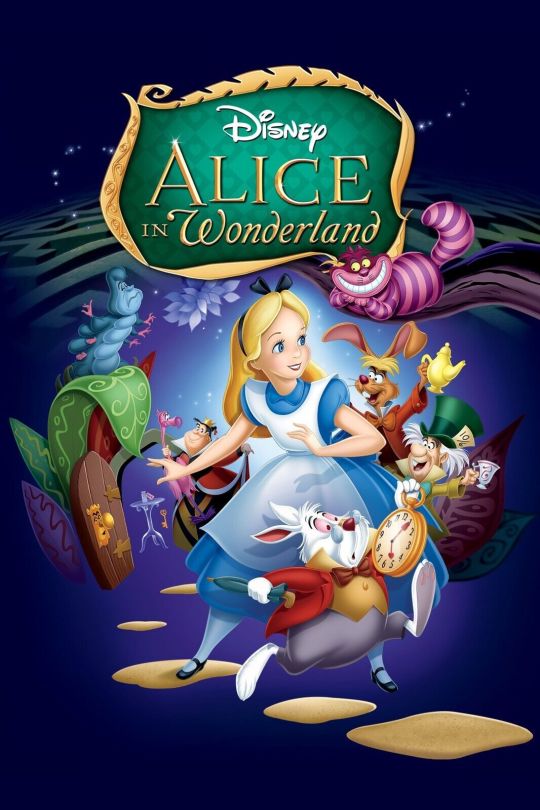
This is the other film, alongside “The Great Mouse Detective,” where I feel – if you know me well – it’s high placement will not remotely be surprising. Whereas, if you don’t know me well, it will likely be VERY surprising. Honestly, I can settle why “Alice” is so high on my list with a single sentence: Lewis Carroll’s “Alice” stories are my favorite books, and I personally think the Disney version is the best movie treatment of the books, as well as one of my personal favorites. That’s really all I NEED to say. But you came here to hear me ramble, I think. Possibly. Maybe. So I guess I have to. :P The history of Walt Disney and “Alice” is actually pretty fascinating on its own, leaving the movie alone: this, alongside “Peter Pan,” was one of the first movies Walt wanted to make, and was actually considered for his first feature film, and then his second, way back in the 1930s. Ultimately, Walt went with “Snow White” for his first film, but he never gave up on “Alice.” It’s pretty clear that Walt loved the story, because even before the Disney film ever got put into development, he’d used Wonderland as the basis for several of his earlier works. There were the famous “Alice Comedies” he produced during the silent era, which were not so much directly based on the books so much as just inspired by them, but are still worth noting. Later there was one of the best Mickey Mouse cartoons ever made, in most people’s minds, “Thru the Mirror,” where Mickey goes through the Looking-Glass, dances with the Queen of Hearts, duels the King, and has to deal with a multitude of animated objects. Initial treatments of the “Alice” story were much darker and more surreal than the final product; most notable was a treatment of the film by artist David Hall, which has sort of become legendary amongst Carrollians and fans of Disney trivia and lost media alike. However, it wasn’t until artist Mary Blair came onto the project – and after World War II drew to a close – that Disney finally felt confident in making the movie. Interestingly, when the film finally came out in 1951, it was something of a disappointment: critical reactions were lukewarm, at best, and it underperformed at the box office. However, over the years – with subsequent re-releases and exposure through various forms of merchandising and rides at the parks – the film gained a bigger and grander following. Nowadays, “Alice” isn’t exactly considered a great Disney classic, but it’s definitely not considered a failure.
In fact, in some ways, one could argue it’s one of the single most influential Disney movies of all time. It was certainly influential on later renditions of the story: coming from somebody whose obsession with the Carroll classics is well known, I can say with certain fact that the Disney film is actually far more responsible for the public perception and love of Alice today than perhaps ANY other version of the stories, including the books. (The only other possible contender is the video game “American McGee’s Alice” and its sequel, “Alice: Madness Returns.” Incidentally, RIP “Alice: Asylum.” May flights of EA idiots sing thee to thy rest.) A lot of things in this film that weren’t in the books now seem to just be accepted as common knowledge: for example, the Cheshire Cat in the books was an ordinary orange or gray tabby cat. The popular purple-and-pink design you’ll find riffed on in some fashion throughout so many interpretations was ENTIRELY the invention of Disney; it never existed before them, to my knowledge. Similarly, characters and story elements that are in the books but WEREN’T in the Disney film tend to be forgotten, even if they’ve been used and reused in tons and tons of other adaptations: there are plenty of versions of the Duchess and the Gryphon out there, but since neither of them are in the 1951 movie (nor the 2010 feature made by Tim Burton, for that matter), most people forget they even exist.
Even beyond other versions of Alice, however, the film has had a huge impact on pop culture, and even Disney itself, than most other films in the canon. Heck, at Disneyland, right now, there are no less than four rides that all reference “Alice in Wonderland.” Four! And that’s not even counting any other shows or attractions, or even any of the other rides at other parks. Nor is it counting video games, nor the numerous other Alice reimaginings that have come out and in some way been influenced by the 1951 picture JUST from Disney’s vaults alone, nor the ABUNDANCE of merchandise – both official and fanmade – based on this one movie. It isn’t a film that has the depth of plot, character, and thematics as something like “Beauty and the Beast” or “The Lion King,” nor is it as historically important as movies like “Snow White,” but I think “Alice” makes up for it by just being fun. It’s a fun, weird, psychedelic ride through the wilds of the imagination, and really, that’s always been what “Alice” SHOULD be, at the end of the day. Really, given my love of the story, in general, the REAL question should be not why “Alice in Wonderland” ranks so highly for me…but why isn’t it even higher? All I can say is, perhaps the films that do rank above it will offer some explanation… The Top 5 are upon us! The countdown continues tomorrow with my 5th Favorite Disney Movie! HINT: It’s the Only Modern Movie on The Countdown.
#disney#disney 100#disney 100 special#list#countdown#top 15 disney animated movies#fifteen days of disney magic#number 6#alice in wonderland#disney alice in wonderland#alice in wonderland 1951
13 notes
·
View notes
Text
I was asked for recommendations because of this post, and here are a handful:
The Wicker Man (1973): The quintessential folk horror viewing experience, this movie is exactly as good as everybody always says it is. The soundtrack alone is worth the watch. Has a Wonderland-esque quality, where the main character is thrust into a world where everything he thinks he knows is turned topsy-turvy, and everybody around him seems to be determined to irritate and confuse him into an early grave. If you haven't been spoiled for the ending yet, try not to be before you give it a watch.
House / Hausu (1977): This movie was made in Japan, so most people call it Hausu, but the title card styles it as 'House' in English and has a voiceover that says "House!" at the same time. This is a surrealistic, almost cartoony psychedelic trip of a movie, where characters are named after the archetypes they fall into and special effects are added with hand-drawn animation onto film. Starting out like a parody of slice-of-life high school dramas and quickly getting weird with it, it could be silly and campy, and in some places it is, but I also found it creepy and psychologically unsettling in a way that sneaks up on you and gets right under your skin.
Halloween (1978): John Carpenter's original is a classic for a reason. Unlike many entries in the inescapable trend for masked killers cutting up co-eds that it inspired, this one is a moody, atmospheric, tense suspense thriller broken up by sharp, sudden explosions of violence. This is one of my all-time favourite horror movies and one that I go back to over and over.
Suspiria (1977): This movie is a candy-coloured confection of spun-sugar broken glass, cotton-candy razor wire, and raspberry-syrup blood. The aggressive use of the Goblins' creepily enchanting theme song nearly made me turn this one off in the first few minutes, but I stuck with it and I'm so glad I did. This is one you want to watch if you're looking for a Grimm fairy tale updated into the modern day (in 1977), built around a series of baroque and dramatically stagey murders.
The Haunting of Julia / Full Circle (1977): 1977 was, apparently, a good year for horror. The Haunting of Julia, or Full Circle, depending on the country of release, is a psychological ghost story with an absolutely gorgeous set and soundtrack. Is Julia really being haunted by a ghost, or just her own guilt? By the end of the movie, you may still not know for sure. This one is truly a horror movie for those of us who grew up on the 90s A Little Princess and The Secret Garden movies. (Just bear in mind that the abdominal thrust manoeuvre for helping choking victims, popularised by Dr. Henry Heimlich, wasn't common public knowledge until after an info campaign in the early 80s.)
Let's Scare Jessica To Death (1971): This is such a surreal nightmare of a movie that in the end, you may end up questioning whether any of the violence actually happened, or whether its perpetrator was really who it seemed to be. Don't go into this one for the plot (it doesn't make a whole lot of sense), go into it for the imagery and the slow ominous rising dread (and the possibility of ancient immortal vampires).
I've also got Valerie and Her Week of Wonders (1970) and Nosferatu the Vampyre (1979) on my list to watch.
There's something about seventies horror that reminds me of live theatre, actually. The sets and costumes are often cheap, and when it comes to period pieces, more 'inspired by' than accurate; the makeup is big and visible; even when the effects are really good, the blood is usually unnaturally red. The acting tends toward the broad and stagey.
And yet, it's also clear that realism is not the goal. Rather, the movie works to draw you in to a unified fiction, to get you to share in its nightmare. The best seventies horror I've seen has a dreamlike, Vaseline-lensed quality, a sense that it doesn't matter whether or not everything that happens in the movie is likely or even possible in real life. We've stepped outside of real life into a self-contained bubble with its own logic and its own sense, a dark fairy tale where the corpses of young girls might transmute into hares or eternally hungry floating heads, or the night of All Hallows might summon a stalking, unkillable masked evil from the past, or a ballet studio might be entirely controlled by witches. Even the lowest-budget, most exploitative Hammer flicks don't escape the touch of that dreaminess, that velvety, enfolding unreality. The movie suggests a world, and we, if we are wise, gladly succumb to the power of that suggestion.
#to watch#if you are at all a fan of 70s horror you've probably seen most of these#but then if you are a fan of 70s horror my post is probably not your first exposure to 70s horror#was thinking about it and I think Francis Ford Coppola's Twixt (2011) actually has more in common with 70s horror for these reasons#than it does with anything else that came out contemporaneously with it#which may be part of why it bombed so hard#(however. I love it.#and despite it not being 70s horror I do also recommend it if you like 70s horror)
1K notes
·
View notes
Text
Exploring Brazilian Culture!

Below excerpts represent a virtual study of Brazilian culture by Columbia College Chicago (CCC) undergraduate students enrolled in the Humanities, History and Social Science (HHSS) Dept. online course: HUMA121 “Latin American Art, Literature and Music” .
This virtual showing on tumblr is hosted by CCC students enrolled in this HHSS Dept. course with its instructor, Jesus Macarena Avila. This investigation began with a study on Tarsila do Amaral and her involvement with the cultural movement: Antropofagia.
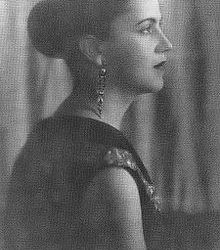
Amaral with creative intellectuals like Oswald de Andrade and Anita Malfatti advocated a new ideology, the Manifesto Antropofago.
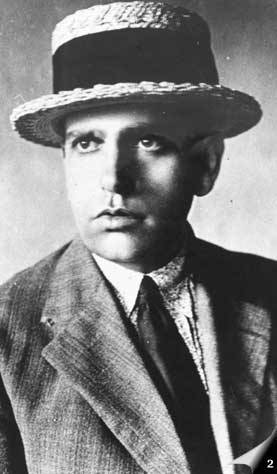
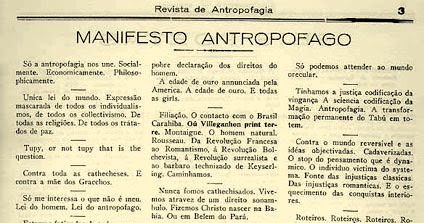
This investigation was only enhanced by the course's online contributors and guests: Dr. Roberto J. Tejada and Ariani Friedl. Dr. Tejada's expertise of Latin American art history and knowledge on Amaral's cultural production.
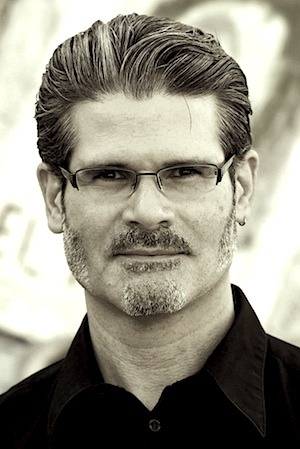
Dr. Tejada gave cultural and historic interpretations of Amaral's paintings like "Carnaval em Madureira" (1924, oil on canvas, 76 × 63.5 cm) showing the Afro Brazilian influence on the work.

Below are students' comments on what was learnt from Dr. Tejada's lecture:
"The speaker Dr. Roberto J. Tejada did an amazing job really helping me comprehend what was going on, and the different and creative ways with the European side and the afro American side were trying to solidify the culture and understanding of one another’s history."
"Amaral is also well known for creating the work of 'Anthropofagia', according to Dr. Tejada, in which its 'main intention was to create a mythic space in a language of painting through using bold colors and unusual forms, in order to create a vision specific to Brazilian history and attending to contemporary human geography/landscapes'."
"Dr. Tejada gave a great explanation of Amaral’s painting Anthropofagia. Made in 1929, its intention was to create a mythic space in painting using non-contemporary forms and vanguard themes to connect to Brazil's history of violent colonialism."
"Some background information about that Dr. Tejada touches on the fact where many Brazilians might have come from. The government encouraged immigration for the most part from Europe. Around the year 1888, the population contained many white Brazilians but also as well many black Brazilians.
Brazil was also one of the last countries in Latin America to abolish slavery. So even from then on racism was something that was influencing many policies (specifically Immigration policies), systems created in Brazil, etc."
"Dr. Tejada made a good point when he stated 'the word itself, signifies the Tupi language and enhancement, it seems to serve the undeniable presence of indigenous people. The indigenous culture is elevated and given importance just as any other subject European painters would put forward’."

And Ariani Friedl (above) representing Chicago's annual cinematic program: Mostra Brazilian Film Series gave an insight to this year's film programming.

Friedl was recently interviewed by Illinois Latino Voice's TransLatinx artist, Jesus "Jesse" Iniguez, this is an excerpt:
Jesus "Jesse" Iniguez: Due to the national Shelter in Place order, how has Mostra become more accessible to a wider audience this year?
Arian Friedl: Due to the pandemic and the impossibility for us to have a MOSTRA in person, we decided, as many other organizations, to present our MOSTRA XI virtually. This has been a completely new field for us and we have had to learn a great deal of new techniques and ways of doing a festival.
JJI: As with previous festivals, What film(s) are this year’s highlights? What are the themes or concepts being featured for Mostra Brazilian Film Festival 2020?
AF: As you know, MOSTRA present Brazilian films with social conscience and every year we bring films which address different aspects of Brazilian culture, environment, social issues, history and others. This year we will be featuring films related to our political history, environment, gender and race issues and others.
JJI: Thank you so much for your time during our “new normal”. You can find Mostra’s film listings on their official website: http://mostrafilmfestival.org/xi/

Below are student/instructor film review excerpts:

"Amazônia, o Despertar da Florestania", Dirs: Christiane Torloni & Miguel Przewodowski, Documentary/1h 46min/2018 (Portuguese w English Subtitles)

"How has Brazil dealt with nature and its natural resources in the early 20th century? What state is the Amazon Forest in? Based on interviews with specialists from the most diverse areas and the rescue of historical figures, the notion of forestry is discussed: the citizenship of the forest, a term necessary to reflect on Brazilian identity.
Although dramatic, sometimes bordering on desperate romanticism, the questions raised by the documentary Amazônia, the Awakening of Forestry are treated with the necessary urgency and a very welcoming tone by the actress, environmental activist, and now even filmmaker Christiane Torloni.
In her directorial debut, Torloni accesses something profound, mystical, and sacred, but no less concrete or vivacious: the surreal power of the Amazon rainforest – and the risk of its disappearance.A documentary film of a conventional format like this only works with the cast's quality and constitution.
A movie like this is only as good as the level of testimony it collects and makes available to the viewer. Fortunately, there are media personalities of weight, prestige, and intelligence, from the fields of art to sciences. All are coming together to trace and unravel the devastating panorama in which we find ourselves as a society." -- E. Reynaga
View trailer here: https://m.youtube.com/watch?v=0Dvm-VH1L8k

"Açúcar", Dirs. Renata Pinheiro & Sérgio Oliveira, Fiction/1h 30min/2020 (Portuguese w English Subtitles)

"Açúcar is a surreal but haunting portrait of an aging sugar cane plantation. It centers on the main character, Bethânia Wanderley (played by Maeve Jinkings), a last remaining family member of a historic Brazilian plantation family. She tries to repair the old mansion and thinking of new crops to revive the plantation industry.
Although this is a fictional tale, it does reference actual facts about slavery in Brazil (being the last Latin American country to abolish slave ownership). As the story progresses, Bethânia begins to see or "hallucinate" things around the old mansion, is it the Wanderley's past with slavery? Or is it the local people, descendants of slaves plotting to get the aging land back? Is it this about “revenge” or reclaiming human rights?
It's beautifully photographed against a sugar cane landscape referencing Afro Brazilian beliefs in Orixas and body possession. Directors Renata Pinheiro and Sérgio Oliveira has won awards for their own films and this feature is a collaborative work at re-looking Brazil's slavery and the history of plantation families." -- J. Macarena Avila
View trailer here: https://m.youtube.com/watch?v=rQBfzNZMags
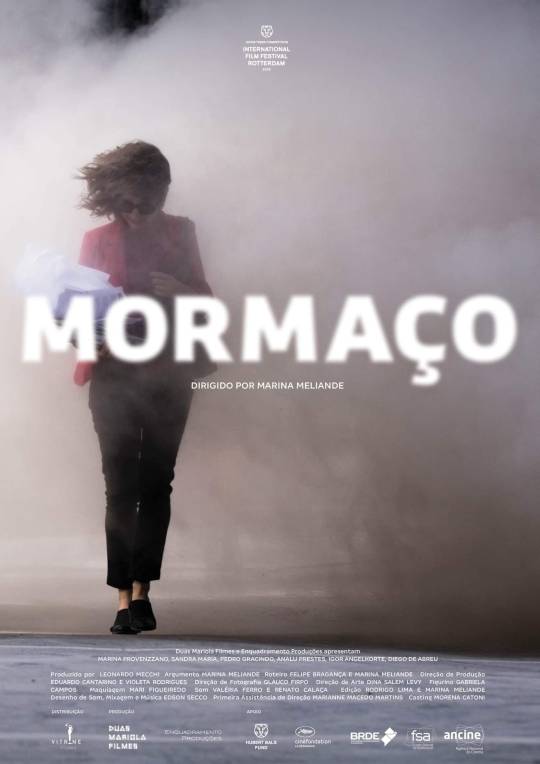
”Mormaço", Dir: Marina Meliande, Political Drama/1h 36min/ 2018 (Portuguese w English Subtitles)

"Mormaço combines different genres, fantasy, political, drama, etc. using visuals to make social commentary about 2016 Rio de Janiero's Olympics. That year, many resident areas were displaced to create attractions for tourism for the Olympics.
This feature is a dazzling, but slow burner story using different genres based on true events surrounding the 2016 Olympics when one of the hottest summers faced Rio de Janiero's area.
It centers on a public lawyer, Ana representing residents being threaten to move. The residents have regular meetings with Ana to prepare to lobby against the city government. Then Ana develops a unknown medical condition that starts a metaphorsis that only complicates her life." -- J. Macarena Avila
"After viewing the film I did some research and learned from an article titled 'Film Mormaço Interweaves Fiction and Reality to Retell Story of Vila Autódromo Evictions' that these events in the film are based on historical events that actually occurred.
The article also states that Mormaço 'makes use of actual footage of these events.' Many of the scenes illustrating war and protest are primary sources that I found very interesting.
Knowing this about the film made me want to watch it a second time to catch all of these primary footages. Mostly because of how seamless the transition from historical footage to current footage. Overall, I felt the film was not only entertaining but also informational." -- J. Heflin
View trailer here: https://m.youtube.com/watch?v=FwSanEqppds
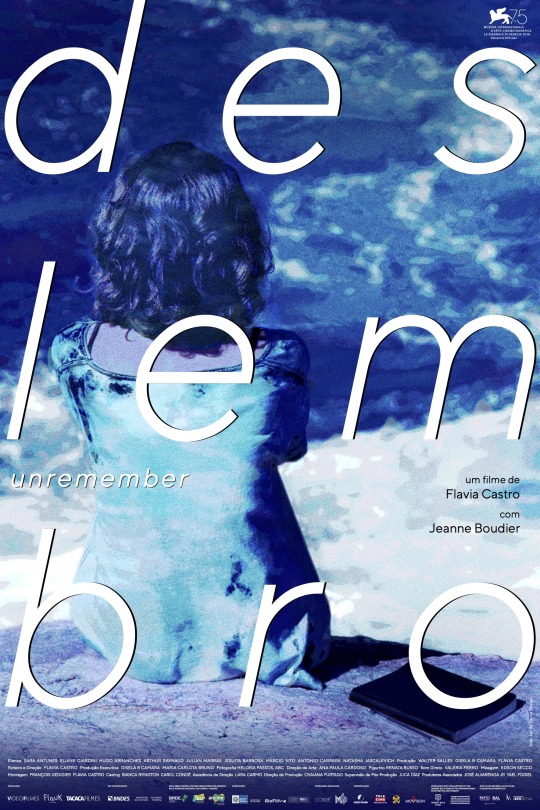
"Deslembro", Dir: Flávia Castro, Drama /1h 36min / 2018 (Portuguese w English Subtitles)
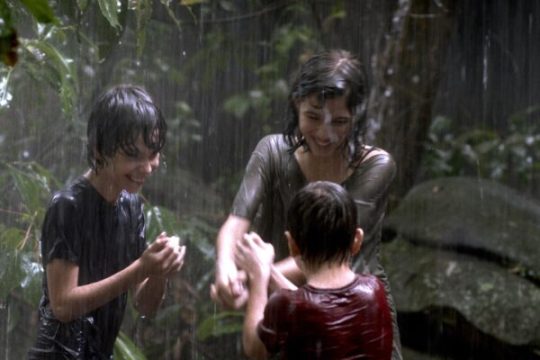
"Quickly summarizing this movie, it’s about a girl named Joanna, who lives with her mom, stepfather, and two stepbrothers in Paris. Her parents announce that they would be moving the family to Brazil and it is very clear at the beginning of the movie how Joanna feels about the decision. Of course, the move is inevitable and the rest of the movie is located in Brazil.
The move to Brazil allows Joanna to be able to explore new things, like the world of literature, her first love, and she awakens politically. Being in Brazil seems to bring up a whole bunch of old disturbing memories from Joanna’s childhood that have something to do with her fathers’ disappearance which then leads Joanna to have a slight hope that her father may be alive.
Leaving this paragraph on a cliff hanger just in case anyone ends up wanting to watch it. I believe that this was a very well written and portrayed movie. It caught my interest because it just seemed relatable. Something realistic, unlike this other movie that I was interested in watching which seemed more fiction based." -- Y. Contreras
View trailer here: https://m.youtube.com/watch?v=4qFP5cbmyEg
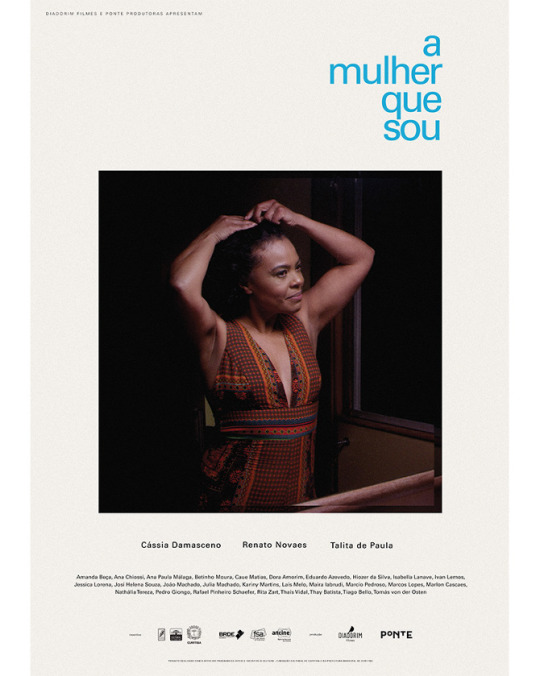
"Mulher Que Sou" (15m), Dir: Nathalia Thereza (Portuguese w English Subtitles)

"The film 'The Woman Who I Am' follows a single mother who is in search of a new beginning away from what appears to be the rural lifestyle she once lived. We immediately begin the story following our main character, Marta, who is traveling alongside a mountain by bus before abruptly switching to a highway where she continues her travel into the city. Later, as she is searching for apartments we are introduced to her daughter who she consults with during this process.
This establishes for the audience their relationship with one another but also theimportance of and emphasis placed on the value of listening to her daughter and including her in this journey. While the prevailing theme of this film, I contend, was identity, we also can identify themes of femininity, single motherhood, modernity, and beauty all woven into the dynamic of Marta’s character.
These intersections help us to understand and even challenge the ways in which we often place mothers in society, especially those that are single or value women past a certain age, questioning their worthiness to be called beautiful" -- G. Paredes
"Oddly enough, the Woman I am was probably my least favorite out of all the films I watched at Mostra. Don’t get me wrong I still enjoyed the film and thought it was pretty good, but it had a lot of potentials that was wasted. There were scenes where the dialogue was too rushed and others where nothing was happening for a particularly long time.
One thing I don’t like is that they didn’t show you some things. For example, the characters would be talking about something off-screen, and the way they were talking about it, you would think it would be some, what of a big deal. They didn’t show the thing in that scene and I thought they were leaving it to be some sort of reveal later on in the film.
But it never gets mentioned again and the audience never gets to see what the characters were talking about. In my opinion, it would’ve been fine not to show it if it was a quick mention but the character made it seemed like it was kinda important.
A reason I did like the film’s 'secretness' is that it captured what the film was supposed to be about: a mom and daughter moving on from their past to a new beginning." -- K. Williams
View this short here: https://m.youtube.com/watch?v=05-F8PDvxdY
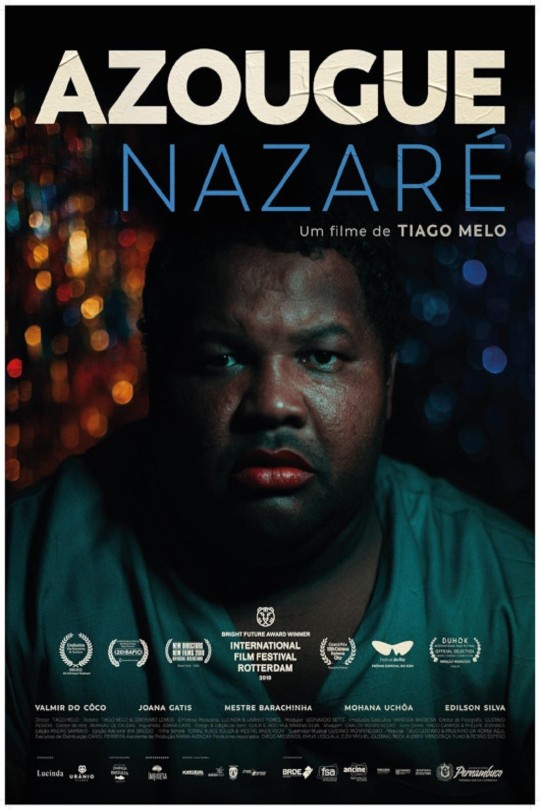
"Azougue Nazaré", Dir: Tiago Melo, Fiction/1h 22min/2018 (Portuguese w English Subtitles)
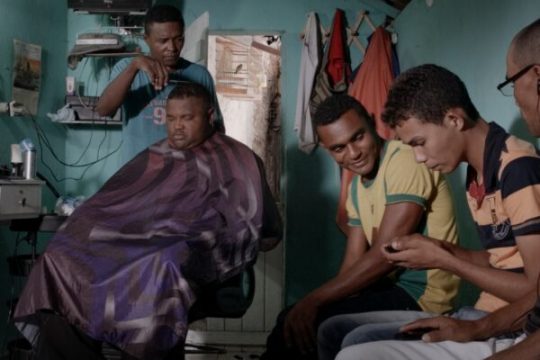
"The film Azougue Nazaré was a drama film released in 2018 directed and written by Tiago Melo. The film is about the start of a new destructive supernatural phenomenon and different spiritual ideologies that collide within this community.
The film touches on religious topics and events in Latin American and was very informational and entertaining. I felt that this film was well put together and although I was not used to many of the different rituals and traditions are shown in the film.
It was very easy to follow along and even relate some of these traditions to ones in my culture. I usually would never go for a film that has to do with religious topics but the film’s artistic values and images caught my eye." - J. Heflin
View trailer here: https://m.youtube.com/watch?v=NFxE51n0IQo
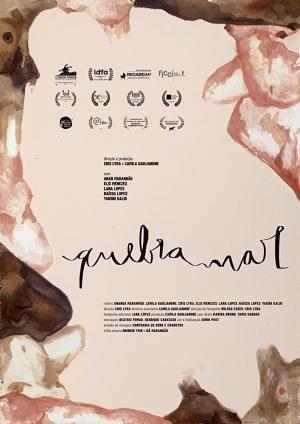
"Quebramar", (27m), Dir: Cris Lyra (Portuguese w English Subtitles)
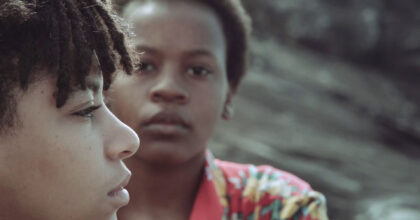
"Going off of Mostra Festival’s description of the film, Breakwater (Quebramar) is a movie about a group of girls from São Paulo who takes a vacation to a remote island for the New Years. While on this vacation, the girls hang out, form a connection, build a safe space, and discuss with each other their experiences being in a part of the LGBTQ+ community.
The things that caught my attention most about this movie and made me want to watch it were the categories 'LGBT' and 'black perspective' because those both relate to me. The movie was filmed in the style of a documentary, though I couldn’t really find any proof it was.
If the film was scripted, then I have to give a huge round of applause to the actresses because they delivered them seamlessly and made it feel natural.One of my favorite things about the film is how casual it was. It was a feel-good film where everyone was having fun, bonding, and really supporting each other." -- K. Williams
View trailer here: https://m.youtube.com/watch?v=xNDquFNV9dQ
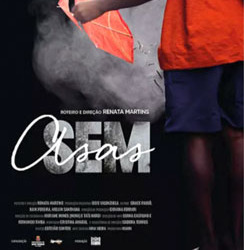
"Sem Asas", (20m), Dir: Renata Martins

"Sem Asas, or Wingless in its English translation, is a short film about a boy with a longtime interest in flying discovering he 'can'. I watched this movie because it was under the category 'black perspective' but I enjoyed it so much because it broke a lot of basic representation the media gives us.
The film mainly centers around the boy but also features his parents. I mention this because the movie really focuses on this family’s strong bond. That’s one thing media rarely gives movies, films, T.V, and etc that focuses on black representation. There’s always one parent (usually the dad) missing or dead and if both parents are there, the marriage is toxic and on the verge of breaking.
This family however is very close and from what the movie showed us very healthy. They help each other out when asked, joke around, lightheartedly tease each other, and were overall worried for each other. Another thing this film didn’t do that most media does was only make it about struggle.
I won’t lie the Black community does have a lot of struggles and situations it has to deal with but those things are usually the only thing media recognizes us for. While the representation of that is important, it starts to build an image in your head when that’s pretty much the ONLY time you see yourself and your community focused on in media.
Yes, there is black on black violence, broken family, major poverty, and many other things but that’s not all the black community is. I think Wingless did a good job of portraying this."-- K. Williams
View trailer here: https://m.youtube.com/watch?v=ZPkWmJvC-Tc
This for educational purposes and co-hosted by

Friedl's video introduction (created/produced by Sara Vianni) to enrolled students in the HUMA 121 course, "Latin American Art, Literature and Music".
youtube
3 notes
·
View notes
Text
The Not-So-Amazing Mary Jane Part 6: AMJ #1

Previous Part
Next Part
Master Post
Now we’ve finally established all necessary contexts we can begin diving into the AMJ series proper. My intent is to break down each issue page by page.
Let’s get started.
We open with Mary Jane shooting a sizzle reel for the film’s investors. Evidently she is playing Mysterio’s super powered love interest.

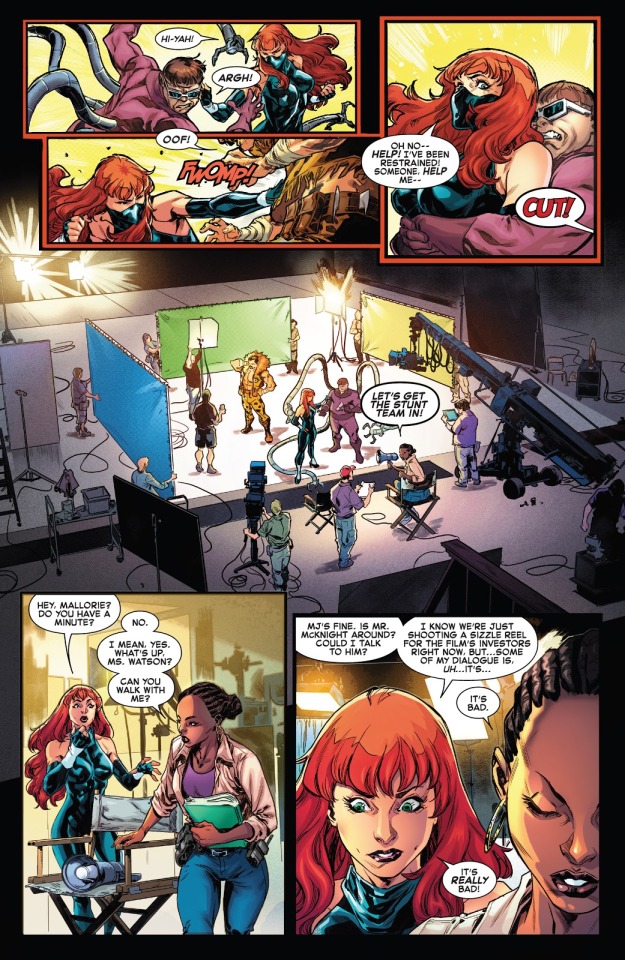
Here we get into our first few problem but I admit it might not actually be a problem.
See, ASM v5 #29 established that MJ has already seen McKnight’s ‘reel’ so why are they filming another sizzle reel?

I admit to being in the dark about Hollywood practices so this might be perfectly normal and therefore not a contradiction. Let me know if that is the case.
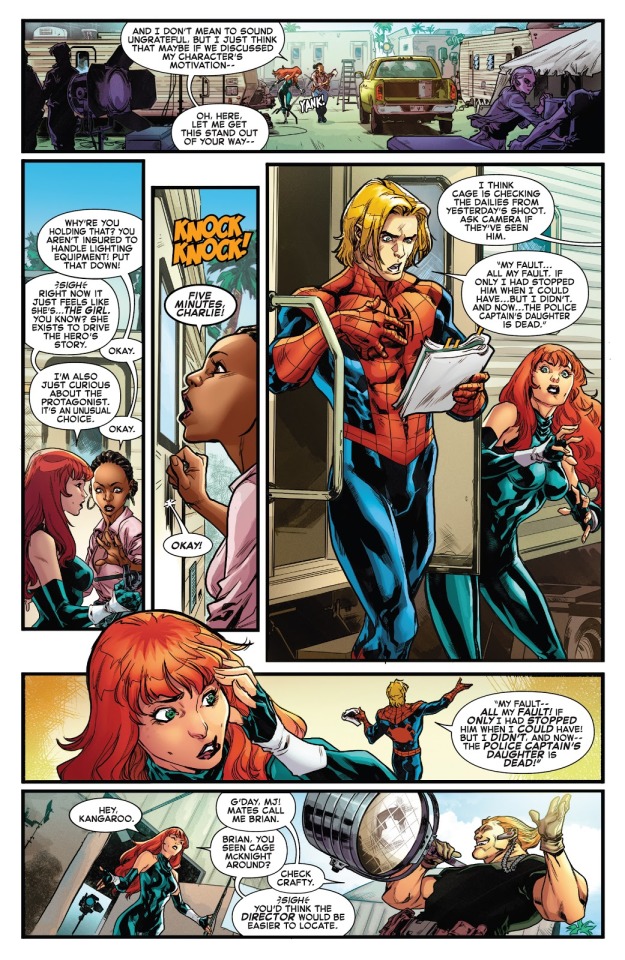
This page introduces yet more problems though they too are rather minor.
The smallest of these is depicting Kangaroo as Australian. Last I checked (and I admit I might be mistaken about this) the Kangaroo was in fact NOT Australian. Or at least this version of the character isn’t as he is the second Kangaroo merely inspired by the original.
That’s a tiny nitpick but I thought I’d mention it. And it’s one that’s easily explained away. He could be emulating an Australian accent for effect or something like that.
The more notable problem is that MJ is deriding the script. This contradicts MJ’s statements in ASM v5 #29/830 where she is praiseworthy of the writing after immediately reading through some of it with Peter.
You could argue that perhaps MJ was commenting upon the script in general and not specifically her own part. As in her starring in this movie would be great for her career because the movie in general was looking to be great. Or alternatively the script for the sizzle reel was bad.
But consider that the script is directly based upon Webspinners #1-3, which (again I might be mistaken about this too) I do not recall ever featuring Mysterio’s would be lover as anything like a super heroine.
Again, this is reconcilable. Rewrites happen. Embellishments on the truth happen.
But to me the reality seems be that either Williams was unaware of the movie being based upon Webspinners (which is entirely possible) or that she wanted to go in another direction for the story.
Either way, it’s a weakness of the comic book but not a deal breaker of a problem.
This page also represents one of the problems from an analytical standpoint with this series.
There is a certain amount of ambiguity through the writing and art in regards to what Mary Jane (and other characters) might be thinking and feeling.
Look at MJ’s baffled face when looking at the Spider-Man actor on the above page.
My initial impression was that she could be simply weirded out by seeing an overdramatised version of her lover. In particular when he’s going over a tragic event in his and her own life (Gwen’s death).
It could just be bafflement over why that’d even be in the movie. After all what has Gwen’s death got to do with the life of Mysterio. I guess Spidey’s implication in Gwen’s death was public knowledge but it still has nothing to do with Beck.
Alternatively that facial expression might (and I emphasis this as speculation) represent MJ’s confusion and concern about that being included in a film. That is to say that’s something of a personal cut for Spider-Man and Mary Jane’s life. She could be wondering if someone knows the truth about Peter’s identity?
If the latter is the case it might go some way into alleviating and explaining other problems I have.
But I just don’t know, because the comic is not making it clear-cut. To my eyes that look says ‘this is so surreal’ and doesn’t say ‘This is concerning. Could Peter and I be in danger?’
However if that was the intention it might’ve been intended to then organically transition into the acknowledgment that there are literal super villains on set and the consequent page in which MJ comments that Cage McKnight fleeing is suspicious.

Here is where we’re starting to get into the bigger problems, but let’s start with a smaller one.
The scene implies that McKnight is a an actual person and a respected filmmaker. This is again contradictory to ASM v5 #29. There MJ referred to McKnight as very new, as someone who lacked an agent until very recently. The implication by Spencer was clearly that McKnight was a false identity that Beck invented. Williams/the editors is clearly ignoring that. That’s not a good sign, although it’s not irreconcilable. It’s entirely possible that MJ’s dialogue in ASm v5 #29 in-story was actually true.
Mary Jane comments that there are felons on set. She didn’t question this because Cage McKnight has a reputation for authenticity.
This line can be interpreted one of two ways.
a) MJ didn’t question actual criminals on set and didn’t do anything about it.
Or
b) She phrased herself badly and what she meant was former felons, or that she presumed they were reformed/reforming felons.
The latter is a-okay, the former though....wtf?
MJ’s lived with a man who she knows spent most of his life torturing himself over allowing ONE criminal to walk free. She’s on set with a whole crew of criminals, including super villains and she’s shrugging it off? She’s not even questioning it?
‘Authenticity’ be damned, it’s illegal and potentially dangerous to knowingly harbour criminals, let alone super powered ones.*
But again, I’m willing to give the benefit of the doubt on that line. Between Cage’s reputation and the fact that so many criminals are working out in the open its not unreasonable for MJ to take it on faith that everything was on the up and up (even with the presence of super villains). After all the only confirmed super villain on set is the D (or Z) lister the Kangaroo who has at times been one of the good guys.
Mary Jane though is smart, socially savvy, can get a decent read of people and did study psychology for a time (she never completed the course but still). So she can tell something weird is up and it���s clear the intention is that she’s been growing suspicious for a while now.
In this essay series I don’t plan on praising the issues as that’s not the point. Besides I do that in other posts anyway. Nevertheless it’s worth pointing out that Williams really hits the mark on MJ’s personality here.
Her statements about Cage ‘claiming’ to have written this role for her (where she conveniently plays the love interest to a super person) and simply handing it to her imply MJ is detecting a trap. This touches on what I said above about her facial expression. About how it’s possibly intended to float the idea that she’s concerned that someone’s figured out Peter’s secret.
However, she could just as easily be thinking this is a trap specifically for her. After all, she’s been targeted by stalkers before (like Jonathan Caesar). That interpretation is arguably supported by MJ’s line about being scammed with an empty promise of stardom. Even if she doesn’t think this is some kind of super villain grand scheme of any kind it’d likely ring alarm bells for any young and (by stereotypical standards) attractive person in Hollywood; at least it would nowadays.
As we move onto the next page Cage reveals himself as in fact Mysterio and confesses he engineered this con in order to tell his life story.
He proceeds to inform MJ what is and isn’t real about the film and explain where the real Cage McKnight is. In doing so he admits that the film is happening through fraud, identity theft (sorry I don’t know the correct legal terminology) and the hiring of former felons and active criminals.
More specifically he produces (what he claims to be) a live video feed of the real Cage McKnight’s location on the Falkland Islands where he will be spending around a year on a film project that doesn’t actually exist. He also claims that this project is his last chance to do something good with the ‘time he has left’ (implying he is dying) and that he wanted to give the felons and criminals a similar chance to make something good and meaningful.
After being honest with her, MJ admits this situation is insane, but then agrees to go along with it.
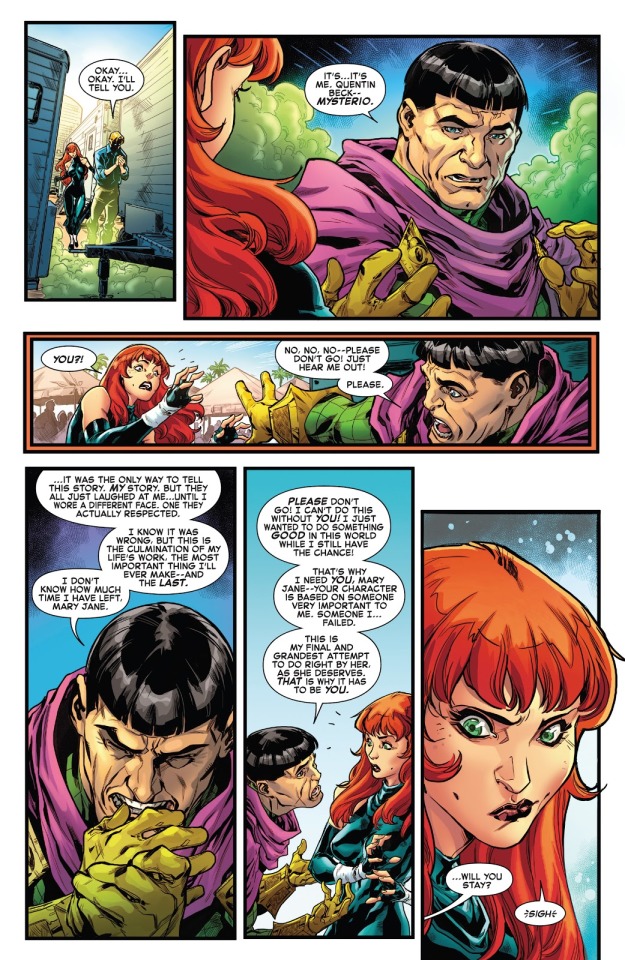
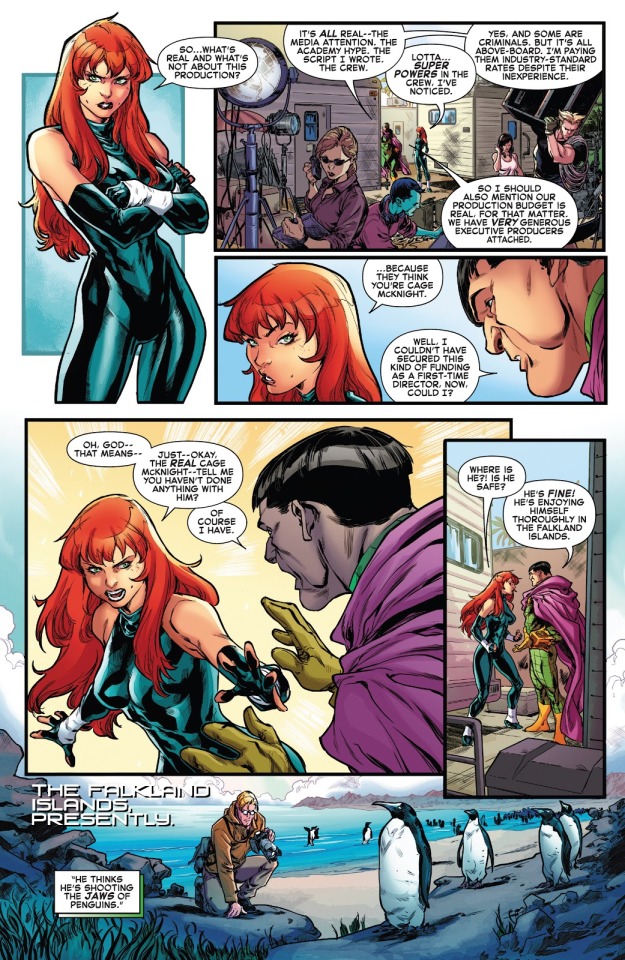
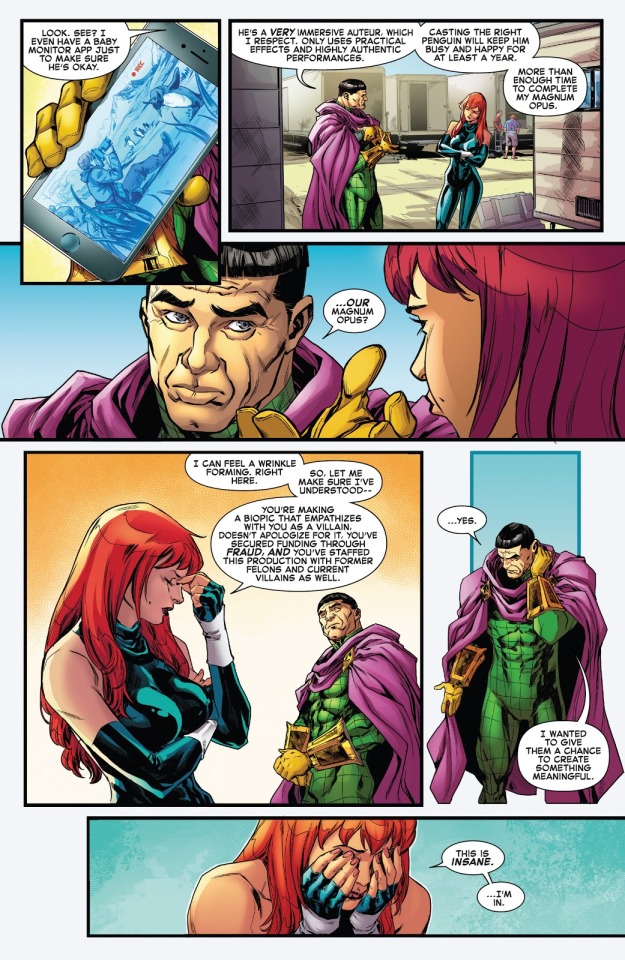
First of all let me get this out of the way. Mysterio has actual active criminals on set but he also wants media attention. Isn’t that counter productive? The media are going to report that (some of the crew are obvious more than human, with green skin no less) and it’s going to cause both unwanted attention from the authorities and problems in general.
With that said let’s talk about the bigger issues with these pages.
Part of the problem in analysing them is that it we have to consider things from the POVs of MJ, Mysterio and our own (which is semi-omniscient).
We know Mysterio:
Is in the employ of the demonic Kindred who’s working a vendetta against Spider-Man.
Faked his own death again back in ASM v5 #24-25
Is doing this movie to make the most out of his time before he is dragged back to Hell
Is aware of Peter’s identity and that it’s highly likely he demanded MJ’s inclusion in the movie (whether of his own volition or on Kindred’s orders) specifically because of her connection to Spider-Man
Essentially we know Mysterio’s reasons for making the movie (including his limited time) are true…but they also omit certain important facts.
In other words…he’s acting.
He has legally (and more often illegally) worked as an actor. He was able to fool executives who literally work in the film industry where actors are basically a prerequisite. He is a massively skilled manipulator.
And here, the context the audience are aware of, conveys that he’s using the truth to get what he wants but is nevertheless withholding the real truth. Maybe this will be addressed later but at the moment it is beyond unlikely that Mysterio truly felt MJ was simply the only person to play his love interest. She is obviously there because of her connection to Peter.
Me personally though, I am not exactly certain Williams wrote this moment with the idea that Beck was being actively deceptive. My personal impression is that she was writing Beck as sincere and simply vulnerable because he knows he'll be returned to Hell soon. This vulnerability would be the reason for his opting for honesty. Now I don’t have any evidence to back that up I will admit, we will have to see as the series progresses.
But the most important thing about this scene isn’t our POV nor Beck’s, but MJ’s.
She is the lead character the person the story revolves around, her actions, decisions and agency is what is paramount in the context of this series.
From that perspective these three pages alone put us several layers into serious mischaracterization.
MJ wouldn’t help Beck because he’s hurt her loved ones
Even if he hadn’t she wouldn’t trust him because of the other horrible things he has done that she knows about
Even if she didn’t know about those things she knows his M.O. and abilities and thus wouldn’t trust him
Even if she sensed sincerity she’d not help him because he’s committed and still committing several serious crimes and unethical actions in this very story
Even if she believed those crimes weren’t so bad and that he was sincere she’d be smart enough to consider the possibility that he’s tricking her and double check what he’s told her
If she presumed (not that there is any evidence of this in the comic) that Beck was out legally and she ignored him obviously engaging in identity theft, she’d still double check those fact and learn that he has in fact escaped.
No matter how you slice this Mysterio is very much in the wrong here and so is Mary Jane. She even admits it’s insane and then agrees to go along with it.
Not only is she out of character to nuclear levels but even if this was a completely new villain MJ had never heard of before the mere fact that he’s clearly committed serious crimes to get to this point and is going to continue to do so (chiefly by impersonating McKnight) should be enough to make her her to bow out.
There is soooooooooo much more I could write about this because it cuts to the heart of the problematic premise as presented by the issue. However I will dive more deeply into that in numerous future instalments once we are done with issue #1.
Moving onto the next few pages, MJ predicates her agreement on the condition that her role be rewritten to improve her character.
This is a fact that she explains will actually improve the film over all. Their discussion occurs as Mysterio gives her a tour of the set and they chat about rewriting her character.**
During the course of this tour Mysterio unveils some of his film techniques and (at least seemingly) confirms what is and is not real about the production. Among the techniques he is using are his incredible holographic technology and his robot duplicates of the X-Men from ASM Annual #1.
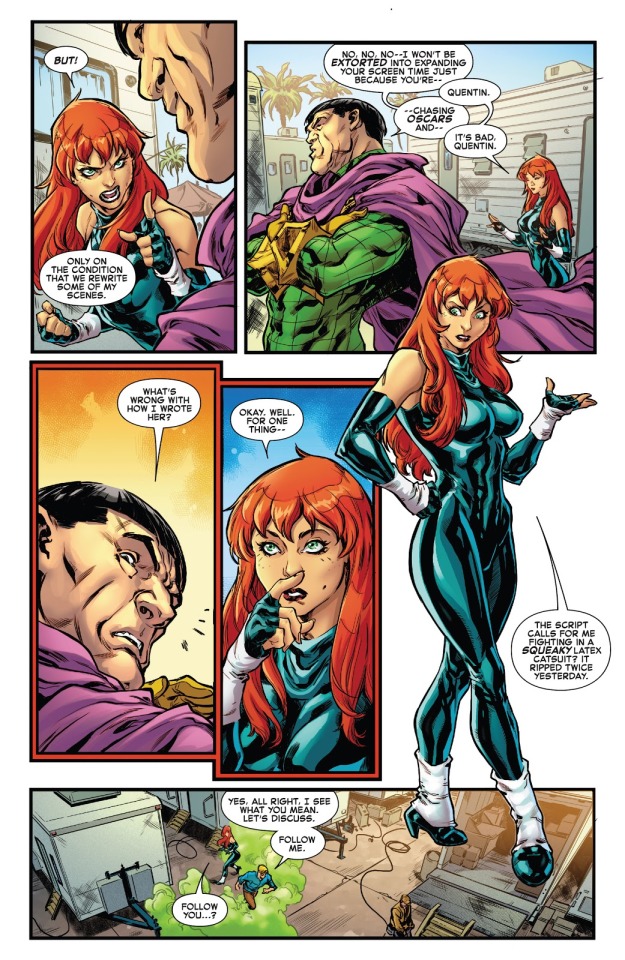
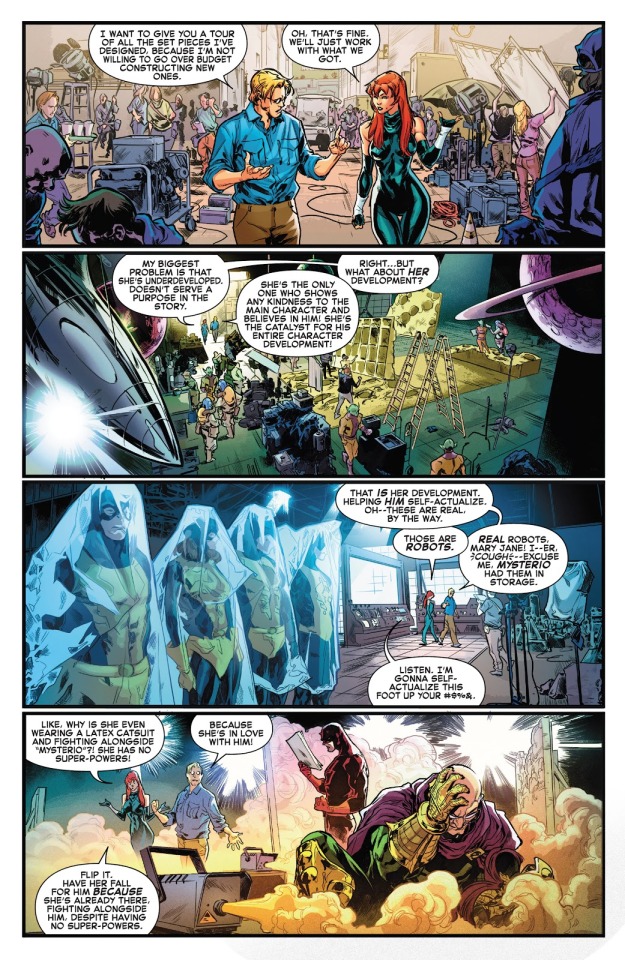
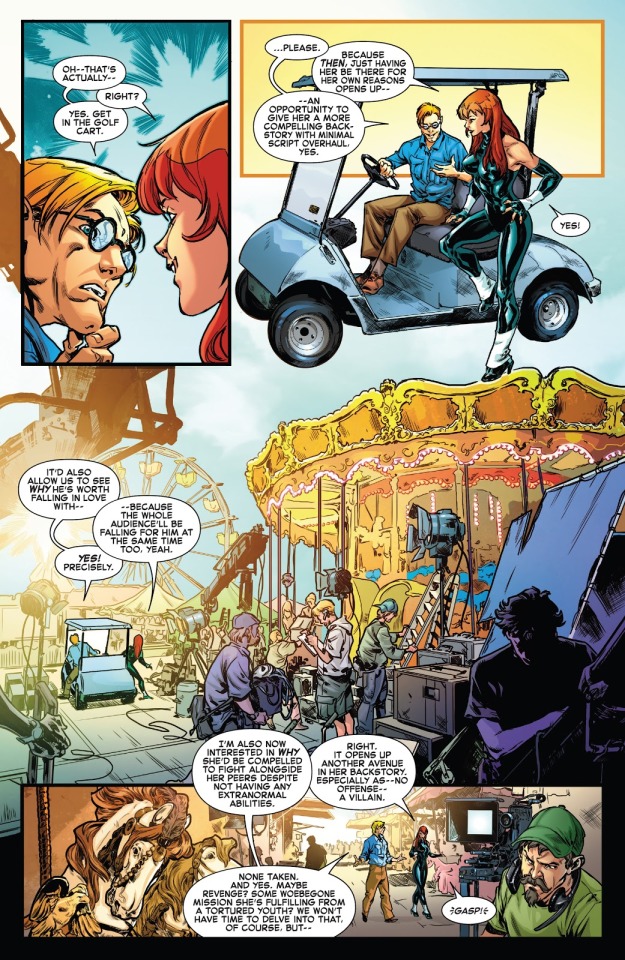
This tour also includes a direct reference to Mysterio’s suicide from ‘Guardian Devil’, implying the artist and editor at least are aware of the events of that story. I’d like to imagine Williams is too. Regardless it’s problematic for the comic to acknowledge those events but treat Mysterio sympathetically in light of what he did in that story. And needless to say it’s problematic to write MJ as so chill around Beck in this scene/comic given how she knows about those events because she was in the story!
Anyway, MJ gets excited by the prospect of a spin off sequel. That in turn prompts one of the crewmen to imply she got her job through ‘womanly wiles’.
This enrages ‘Cage’ who assaults the man, an event witnessed and recorded by the surrounding crew. As she witnesses these events her self MJ has a curious facial expression.
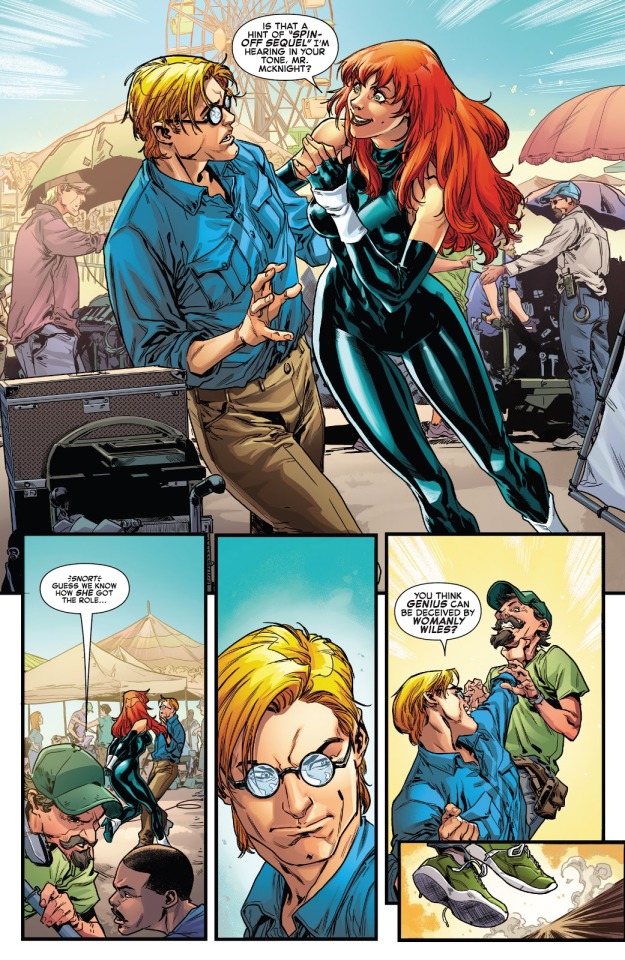

Much like her expression seeing the actor playing Spider-Man, MJ’s face here is difficult to interpret.
It could mean any number of things.
Could she be viewing Mysterio as someone she’ll have to play carefully?
Is she thinking she’ll have to do her best to ensure he doesn’t get out of hand, whether it’s for her own protection or others’?
I do not know. It’s kind of vague. Hopefully it’s meaning will become clear in consequent issues, but if I’m supposed to understand clearly what it means in this issue then Williams or Gomez dropped the ball.
Something they didn’t drop the ball on though is Mysterio’s characterization. It’s worth mentioning out of fairness that this emphasis upon Mysterio as a passionate artist is extremely in keeping with his character and Williams handles him expertly on this front.
Beck finishes up his tour with a recreation of a scene from ASM #66-67 and MJ is delighted by the fun she and Mysterio are going to have in making the movie.
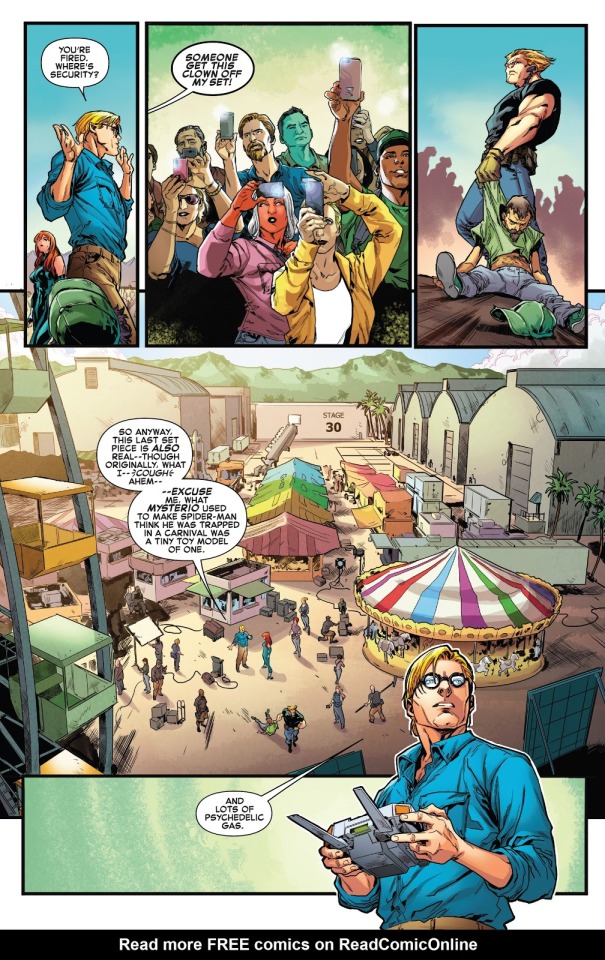
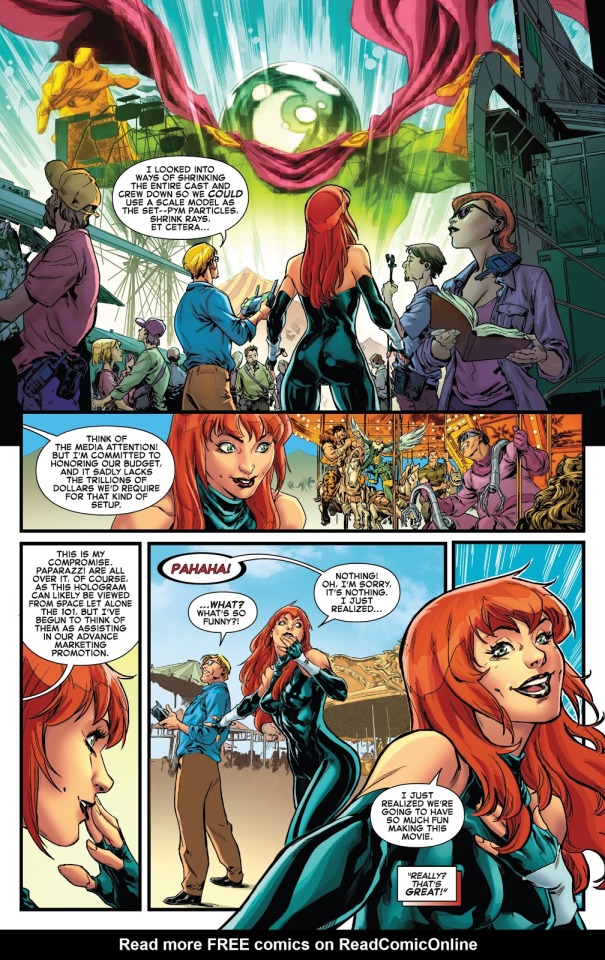
Notice that Beck directly references how this set piece is recreating a trap he laid for Spider-Man, how he used psychedelic gas to trick his mind.
In essence this is Mysterio simply stating outright to Mary Jane that he once tried to harm her boyfriend and even drugged him to that effect.
And MJ’s reaction to this is��to giggle with glee.
Really?
She doesn’t even show any hint of apprehension over that? We the readers aren’t even made privy to an internal tensing or recoiling on MJ’s part to this man just casually mentioning a time he sought to end the life of the man she is in love with?
Seriously, what the fuck. You better believe we’ll be talking more about this too.
Even from Mysterio’s point of view it muddies the waters of his motivations. As we extensively examined in prior instalments, it’s very likely that Beck knows Peter is Spider-Man, and thus by extension probably knows that Mary Jane is his lover. So it’s incredibly stupid on his part to blithely mention to MJ a time he drugged Spider-Man and tried to kill him.
Alternatively let’s say Beck’s hiring of MJ was in Kindred’s orders and he is unaware of the exact connection between her and Spider-Man/Peter. It’s still stupid because he’d still be able to deduce she very probably has something to do with Spider-Man because he knows Kindred wants her out of the way as he wages war on the wall-crawler.
The fact that Beck is written this way indicates Williams is unaware of the Spencer ASM issues which set up AMJ and/or doesn’t care and/or the editors aren’t doing their due diligence . Regardless it’s a major weak spot of the story. It either breaks the larger narrative that exists between the two titles or it renders Beck out of character via his stupidity.
The latter would be true even if Beck simply wanted MJ in his movie just because he liked her as an actress. He’d still be throwing out the fact he drugged and tried to kill someone (a former Avenger no less) in his past.
As the story progresses MJ and Peter have a chat on the phone where she makes a point of alleviating any discomfort he might have over making a sympathetic Mysterio biopic, claiming it is the Breaking Bad of super hero films. She continues by pointing out the career opportunities the role presents.
Peter raises concerns for MJ’s safety, suggesting she might find herself surrounded by villains; ironically unaware that Mary Jane is in that exact situation.
MJ assuages his concerns by reminding him of the time she defeated an actual super villain (the Chameleon, though he goes unnamed) with just a baseball bat.

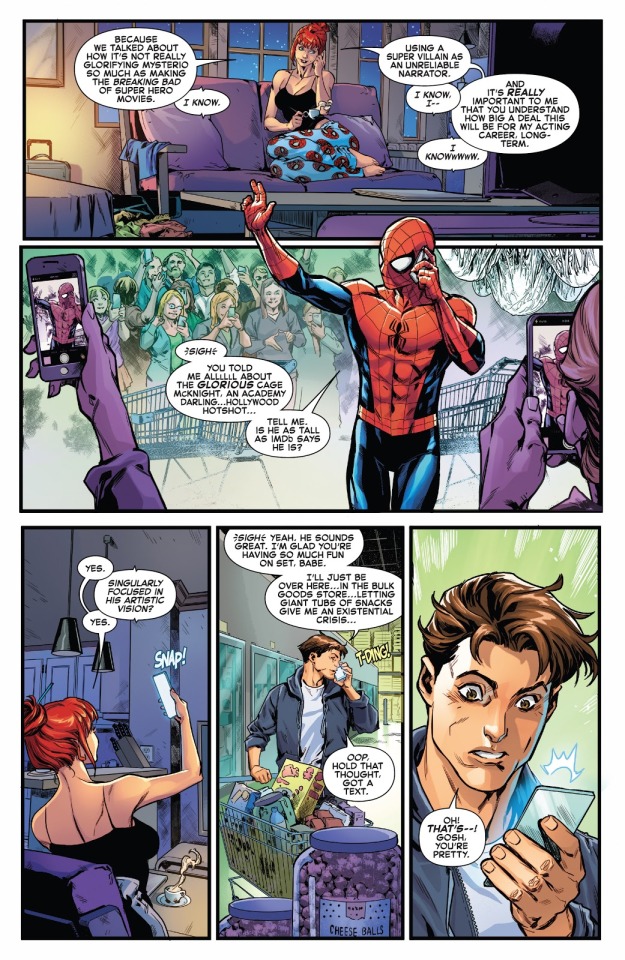
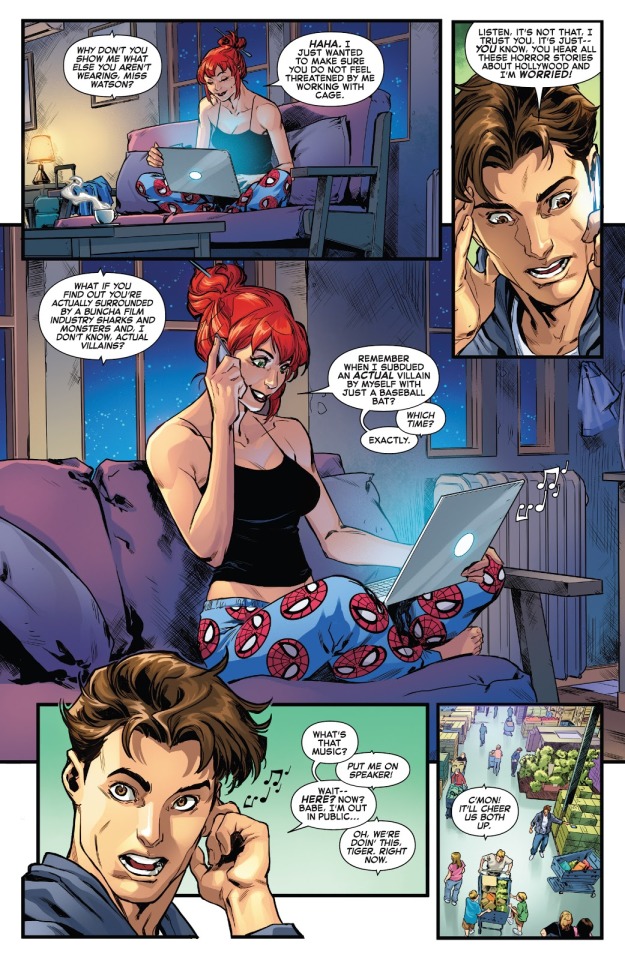
MJ’s statements regarding the movie are arguably contradictory.
Earlier in her conversation with Beck MJ stated that the film empathizes with Mysterio and doesn’t apologise for it.
But then at the end of the story she tells Peter that the film actually isn’t glorifying Mysterio. Rather, it is making the Breaking Bad of super hero movies with an unreliable narrator.
This isn’t necessarily irreconcilable, but it is somewhat poorly communicated on Williams’ part. Breaking Bad’s defining message was that you shouldn’t be like Walter White. That he was in the wrong, even from the very start.
Why would Mysterio ever write a film about himself in that light? It doesn’t make sense and it would contradict MJ’s dialogue about how the movie empathises with Mysterio as a villain and doesn’t apologise for that. Breaking Bad wasn’t empathetic towards Walter White, it showed him very clearly as a monster and its final episode had him admit that fact.
Moreover if the film empathises but never apologises for Beck (and is directed by him personally) then isn’t that tantamount to glorifying him?
Because of this the issue leaves us with three possible interpretations of Mary Jane in this moment.
She is either:
Blinded by the prospect of fame and/or fortune and/or excitement and as such cannot see that the film obviously is glorifying Beck. To an extent we’ll talk more about this in a future instalment. Suffice it to say that’s very out of character
She is outright stupid, which is also out of character
She is deliberately lying to Peter about the artistic nature of the film project. There is a strong case (that we will get to) for MJ lying to Peter about Beck being out of character for her. However, were this a regular film production it might not be an OOC move for her. She wants to make the movie and alleviate her boyfriend’s feelings for the moment. Fibbing to keep their long distance relationship healthy and happy and hopefully being more straight with him when it’s over is not an unreasonable thing to do.
Options 1)-2) don’t exactly paint Mary Jane in a positive light, nor does option 3) necessarily.
MJ just isn’t this stupid, isn’t this capable of being star struck (she’s seen too much serious shit in her time for that) and lying to the love of her life about something like this is questionable. On the latter point it can be argued that there’d be no advantage of her lying to Peter about the project because he’s obviously going to find out when the movie is released.
Personally I suspect Williams never intended to imply any of the above interpretations.
I think she or the editors just didn’t catch that the dialogue at the end of the issue contradicts the dialogue from earlier. Which would be bad writing/editing but not demonstrative of Williams not fundamentally understanding the character. On occasion Stan Lee himself mischaracterized Spider-Man by accident.
Nevertheless a moment that reflects badly upon MJ.
The last moment from this scene involves a ’20 second dance party’ between MJ and Peter.
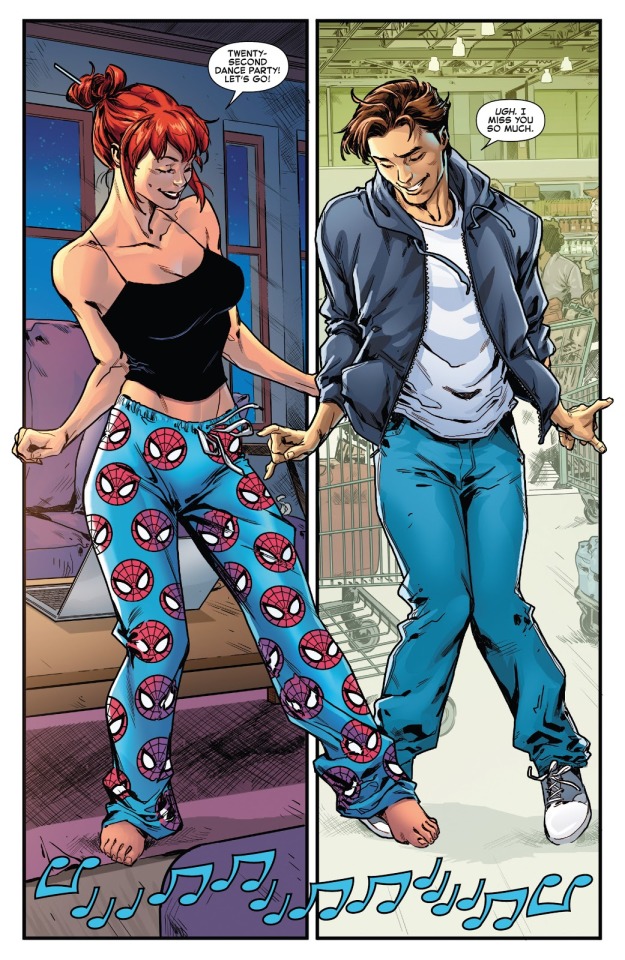
Its only relevance to this analysis is to exemplify some ways in which Williams nails Mary Jane’s character.
She’s flirtatious, she’s vibrant, she loves to dance, she loves to party, she can get the overly serious and often angst ridden Peter to emerge from his shell. Combined with MJ’s savvy earlier in the story, her tenaciousness and references to old continuity I can absolutely understand why Williams seemed like a good pick for the project.
But it’s moments like these that frustrate me about this comic (and I suspect the series going forward). It’s not that Williams fundamentally misunderstands Mary Jane but she drops the ball in a few places. Unfortunately those include drops that are so huge that they break the entire story. At least that will be the case if she doesn’t fill in the holes in her narrative.
The end result though is an extremely mixed bag wherein you have logic holes and mischaracterization so bad it debatably counts as (unintentional) character assassination but at the same time some of the absolute best Mary Jane or Mysterio moments ever! The 20-second dance party is going to be fondly remembered by every Mary Jane fan and MJ/Peter shipper forevermore, and rightly so.
But equally, unless properly justified in the future, MJ knowingly teaming up with Mysterio deserves to go down as one of the all time worst out of character moments for her ever.
The final relevant thing from the issue to talk about is the last page. It entails the Vulture’s gang of villains (the Savage Six) reading an article about the Mysterio biopic and deciding to head for L.A.

This is only really relevant for two reasons.
The first is the set up it supplies for future issues.
The second is that the article specifically talks about leaked set photos.
This further plays into the confusing nature of Mysterio’s scheme. He wants the media interest to act as a form of publicity (arguably this leak is an example of that) but he also has current villains on his staff. Wouldn’t the press be likely to find out about that and thereby jeopardize the project?
Reputation for authenticity or not, that’s extremely illegal.
With aaaaaaaall that said it’s time to move onto dissecting the status quo set up by this issue.
It’s all subject to change of course. Williams might address each and every problem eloquently at some point. But taking it at face value I am going to dedicate one (or more…) instalment(s) of this essay series to exploring the problems presented by this premise.
*We will talk much more extensively about this in a future instalment I promise you.
**By the way I don’t quite understand what MJ is asking her character to be rewritten into. She asks why she’s fighting without super powers but then says she should already be doing that in the story and that this is how she falls in love with the hero?????????????????????? Maybe I’m being dense but that just wasn’t clearly communicated to the readers).
Previous Part
Next Part
Master Post
#Amazing Mary Jane#Leah Williams#mjwatsonedit#mary jane watson#Mary Jane Watson Parker#MJ Watson#Spider-Man#Carlos Gomez#Mysterio#quentin beck#Peter Parker#Savage Six#Adrian Toomes#X-Men#vulture#The Vulture
11 notes
·
View notes
Text
on the lucky 10,000, music, and being intimidated
One of my favourite XKCD comics conceptualises the 'You haven't heard of this?!' phenomenon in a more positive light: “for each thing "everyone knows" by the time they're adults, every day there are, on average, 10,000 people in the US hearing about it for the first time.” If we make fun of people for not knowing things, we taint their wonder - and our experience of their wonder - when they do experience them. It weighs down that experience with the panicky sense of catching up, rather than the joyful sense of getting to finally see a cultural phenomenon.
I've always noticed this problem of the 'lucky 10,000' being more of an 'unlucky 10,000', but university-level quizzing has brought it into closer view for me. So much knowledge I don't have is assumed knowledge in quiz, that discovering new facts can be met by more of a 'wait, you don't know that?' than a 'yeah, it's cool, isn't it?' So often, you feel like you're three steps behind, vaguely recognising that song when the person next to you has already recited its name and composer, and spending hours researching to just achieve the stage of 'basic' knowledge. You can get caught in an unhealthy mental complex where embarrassment at what you don't know outweighs the pleasure of learning it.
Meanwhile, in the public sphere, your painstakingly fought-for general knowledge can be taken for granted, whilst a lacuna in your popular culture experience is pounced on. (Downing College saw this after their Monday episode, when the media 'despaired' when their excellent University Challenge team hadn't heard of Iron Maiden. The same happened last year, when the Emmanuel team (which I was the reserve for) thought a lesser-known section of Stairway to Heaven was Oasis. For the record, I would have been absolutely no help to them, and neither would my mother, who was born in the '60s and thought it was Fleetwood Mac. I actually think it did sound rather Oasis-like.)
Being a quizzer and a graduate student, it's so difficult to see what you haven't experienced as a future joy rather than a present burden. A couple months back, another English student (a lovely and very talented guy) made an offhand comment about 'how could you make it to third year without having read X author' (an author I hadn't read, though he didn't know that). When someone asks me if I've heard of Y author, I often find myself too embarrassed to say a flat 'no' and often opt for the less damning 'yes, though I haven't read any of their stuff'. Rationally, I know this isn't a reasonable anxiety; I should be secure in my abilities in literature now, three years of study is only about long enough to have read something by maybe 200 primary authors (and that's including authors of short stories/extracts), and I'm sure that if the conversation was in my hands, I'd be capable of intimidating people if I deployed my most 'impressive' reading in a suitably nonchalant tone. But as a fairly novice quizzer and a new graduate student, I'm not that secure, nor should I be. I have a lot to learn. And the 'lot' is much harder if the spectres of shame, directionless panic, and What's the Point Anyway are dogging your every step.
Speaking of the Iron Maiden and Oasis debacles, I'd like to mention music in this light as well: I've never understood music snobbery, both of the 'oh my GOD you haven't heard of them?' variety and the 'prog master race / Bieber is cancer' variety. Music is so personal - so bound into how people's brainwaves and bodies and particular affinity for language and melody and rhythm work. (Lawrence Grossberg in 'we've gotta get out of this place' ties affect theory into rock music, if this train of thought interests you at all.) I mostly like electronic / EDM-type music with little infectious cadences which make me reflexively smile or move when I hear them. I can get stuck on how a musician says a particular line for days. I like pop and alt-pop and 'indie' stuff which probably isn't 'actual indie' but it makes me dance and lip-sync when I'm listening on the walk home and that matters to me more than any genre superiority. Fuck, I once got so into a game from a shitty app knockoff of Dance Dance Revolution that I'd have the app on in the background and would repeat the relevant level for hours. Quality is relevant, yes, but so is immanent experience, and you can't police that. If Gucci Gang gives you frissons down your spine, who the hell am I to tell you it shouldn't? Or to legislate what songs should mark your memory of a particular time? By all means look up new stuff, but Led Zeppelin mastery shouldn’t be mandated as a condition of civility. (I presume this is also a chronology thing, too - I’m guessing a more recent acclaimed musician would not have sparked the same furore, Kendrick Lamar for instance. Concretising music as ‘classic’ takes time. But I digress.)
Anyway, to return to academia. Even the most brilliant students can feel the pressure to not show a spot of 'weakness'. A chronic overachiever I know had to take a language exam earlier this year, which meant learning a sadistic quantity of verb forms/vocabulary by heart. I asked them whether revising with others was a good idea, and they sort of looked down uncomfortably and conveyed that they didn't want to admit to others that they were 'needing' to learn this stuff, since it's supposedly 'common knowledge'. After I expressed scepticism that they didn't know stuff everyone else knew, they freely admitted 'Oh, most people don't know this stuff off by heart at all. But it's supposed to be common knowledge.' Talk about a communally sustained illusion!
I don't know how you combat this, to be honest. I tend to just always have a book on the go at any one time, so it acts as an 'excuse' of sorts. I'm reading Joyce's Ulysses for my course next term at the moment - probably the most 'canonical' book I haven't read yet, but treating it as its own beautiful, puzzling, maddening, problematic, intense experience rather than a Basic Bitch Mainstay is helping a lot. (That's what practical criticism is about, after all - taking concretised books and viewing them on their own terms, rather than ossifying them behind ten layers of others' perspectives first.) But it also helps, I think, to be more honest with each other. I've asked a bunch of my friends recently to give me movie ideas - I've seen very few films - and they've been delightedly replying with their favourite movies for days now. Sure, it can feel less 'impressive' to take in the cultural suggestions of others, rather than propagating your own ideas outwards to others. But it's a necessary symbiosis, and I think we all know that. We're just a little afraid to admit it.
P.S. I've just watched the first of the films on the list - Blue Velvet. I like it a lot, I think. It's weird. I didn't know films could really do that. It's surreal but not quite surreal enough that it breaks continuity. And the symbolism at the end feels really heavy-handed, but almost so heavy-handed that it's purposeful? Or maybe not? Stylistically it's mesmerising. So this is David Lynch, huh. I'll have to watch more.
4 notes
·
View notes
Photo
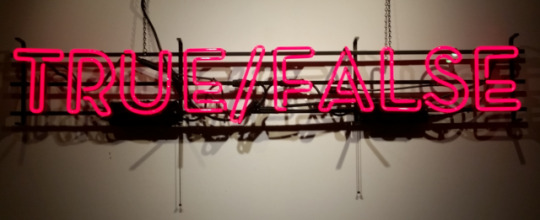
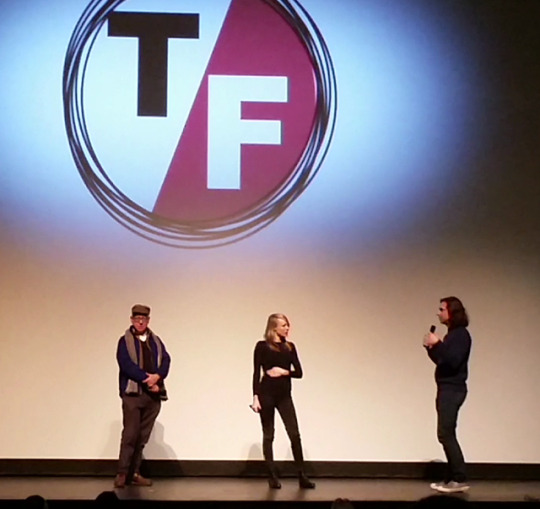
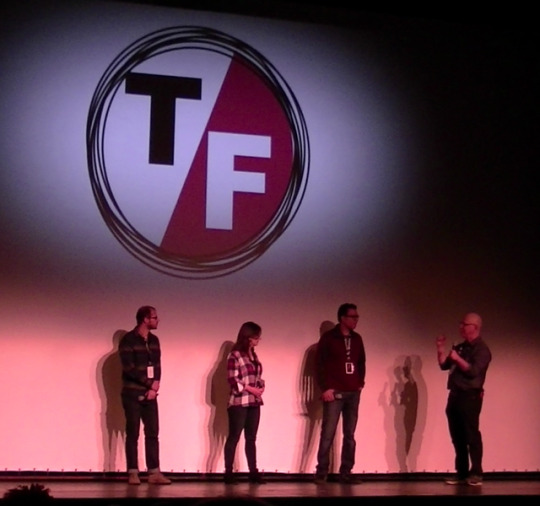
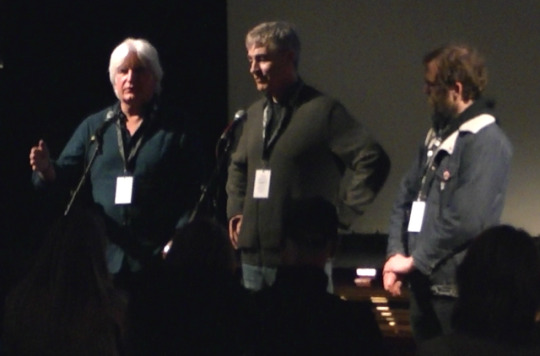
True/False 2017 Festival Report, part 1:
in which I give capsule reviews of films that I viewed on March 2 and 3, the first two days of this year's True/False, in order of best to worst.
Casting JonBenet (Kitty Green, 2017) True/False alum Kitty Green, whose film Ukraine is Not a Brothel divided audiences at the fest three years ago, returned this year with a major work, fresh off its triumph at Sundance: a hybrid documentary experiment called Casting JonBenet. Green put out a casting call in the Boulder, Colorado area -- the site of the murder of child beauty pageant participant JonBenet Ramsey two decades ago -- looking for locals to audition for the roles of JonBenet, her parents, her brother, and a few more figures close to the case. One by one, these actors sit down in front of the audition camera, framed as precisely and hauntingly as an Errol Morris interview, and talk to Green about their knowledge of the case, their theories about the case, their everyday lives, and the tragedies in their pasts that would help them to get into their roles. The audition footage, shot in 4:3, comprises the bulk of the film, but is occasionally intercut with 2.35:1 footage of fragments of what looks like a larger JonBenet Ramsey project that was never made. Lest you assert that this was all underhanded and exploitative to hold an audition for a non-existent film, Green explained in the Q&A that she apprised the auditioners of the nature of this experimental project, and apparently all participants agreed to have their unscripted audition tapes turned into a documentary. Green added in the Q&A that it was quite difficult to explain the project to the auditioners since no one had made a film like this before (though it's actually pretty similar to Mohsen Makhmalbaf's 1995 film Salaam Cinema, but with some added formal ornament). Though the experiment has limited documentary value in the traditional sense, it nevertheless takes the temperature, albeit obliquely, of the community that's lived in the aftermath of this unsolved case. You also get to meet some regular people with stories nearly as bizarre as the role they're auditioning for. What's more, the film opens up inquiries into the nature of documentary truth and how it relates to the different orders of truth that an actor might seek when inhabiting a role. I found it mesmerizing throughout, and a few moments even had me bolt-upright in my seat. For instance, after playing footage of some auditioners discussing the theory that JonBenet's killer was actually her brother (who was a young boy at the time), Green cuts to a montage of child actors attempting to split open a watermelon by beating it with a flashlight. And as if moments like that weren't enough, it all ends with majestic staged sequence in which about two dozen of the actors perform as multiple copies of the same characters on a set of the Ramsey house. It nearly evoked a live-action remake of Rybczyński's 1980 short Tango, but far more operatic and far sadder.
The Force (Peter Nicks, 2017) A couple years back I happened to catch Peter Nicks's debut film, The Waiting Room, a Wiseman-esque documentary about the goings-on a major hospital's emergency room. His institutional focus continues in his sophomore project, The Force, which embeds the viewer in the troubled Oakland Police Department. The film opens just before a police academy graduation, where we see the graduating officers in a tight prayer huddle. The moment the prayer ends, they break into a raucous chant celebrating their identity as the 170th Academy class. And so the film establishes its dialectic: will this department base its esprit de corps on militaristic chest-thumping masculinity, or on a spiritual quest for their better angels? The film takes us on a two-year journey through that question, at times making me believe that the Oakland PD is absolutely reformable, and at other times making me believe that police departments in general, by some basic flaw in their institutional structure and ideological foundation, are beyond saving. The Force is full of great insider footage that gives insight into the trials that beat cops and commissioners alike go through on a daily basis (during an excruciating tear gas training, the cadets are told, "You don't have the right to panic."). Eyewitness on an important moment in police history (2014-2016), the film tells the thorny facts of that history well. But throughout the film, Peter Nicks also deploys a series of subtle and utterly brilliant innovations on the art of observational documentary editing. Let me describe a few moments. Early in the film, a police officer is asking a man questions in a gas station parking lot when the suspect takes off running. Nicks's camera follows the action as well as it can, and a block away the officer tases the man as he's climbing over a fence. A moment later, as the officer describes the incident to justify his use of force, the footage from the incident replays, now intercut with the officer's body cam footage. These two pieces of tape corroborate his story. I know that the replay of footage doesn't sound like a major innovation (it's been around since at least Gimme Shelter), but the moment I saw it, it felt like a quiet breakthrough, or at least a powerful reminder of the evidentiary capacity of documentary, as well as the polytensuality of documentary images. Later in the film, another officer experiences a tense confrontation with an agitated man on the street. The officer manages to prevent violence from occurring, but by this point in the film we've already been made to realize multiple times that the Oakland PD is understaffed and its officers have to work 12-hour shifts that see them going from call to call, non-stop. As the officer drives away (we see him in close-up, with a thousand-yard stare), Nicks intercuts clips from the confrontation along with body cam footage of the same. Here, the replay functions as beleaguered memory. The empathy of the moment is remarkable. There's plenty more to say about this expertly-made film, but it all boils down to one thing: I never thought I'd feel so much sympathy for the Oakland Police Department. From the very beginning, it's clear that Chief Whent sincerely desires to end corruption, that he cares about the community, and that he wants his officers to understand the validity -- even the patriotism -- of the anti-police protests. He tells them, "The core foundation of this country was a mistrust in government. And we are the most visible sign of that government." Elsewhere a Community Liaison pastor invited to address the unit adds, "The past stole your identity and ran up an incredibly high bill." It's a lesson we can all benefit from: we must know our history to know ourselves.
The Road Movie (Dmitrii Kalashnikov, 2016) True/False 2017 marked the North American premiere of this compilation documentary, an alternatingly rollicking and harrowing journey through the Youtube phenomenon of Russian dashcam footage. Director Dmitrii Kalashnikov said he went through over 3000 publicly-posted dashcam clips to make this film, which runs a bit over an hour and features a little over 100 clips ranging from driver's ed disasters to weather-related accidents to forest fire drive-throughs to surreal encounters with drug-addicts, swat teams, meteorites, and wedding parties. As a work of editing, it has some notable qualities -- particularly Kalashnikov's interest in oscillating between the funny and the horrifying -- but apart from its obvious voyeuristic enticements (in the Q&A, Kalashnikov said that all documentaries were voyeuristic), its main strengths are conceptual. For instance, what does it mean to take Youtube off Youtube, transforming it from a private diversion to a public, collective spectacle? What does it mean to make a supercut not of professionally-produced footage, but of amateur footage? If we accept the axiom that footage uploaded to Youtube marks a site of interest or desire (that is, people presumably do not upload footage that they do not find interesting, since they desire that others will take an interest in it), then what might such an aggregation of footage express about the collective fascinations and desires of the culture that produced it? Finally, I also noticed that throughout the screening, many audience members had trouble suppressing an impulse to issue hushed directives or invectives at the drivers of the cars on screen. The perpetual POV must have made it feel like we were watching a friend play Grand Theft Auto -- a friend who clearly, given the number of disasters we saw, definitely needed our advice.
Abacus: Small Enough to Jail (Steve James, 2016) Steve James (Hoop Dreams, Stevie) is a towering figure in documentary. His latest project was made for Frontline, so it's somewhat smaller in scope and ambition, but his skill has not faltered, and the story is an important one. The film chronicles the story of Abacus Federal Savings Bank, which to date is the only bank against which a fraud lawsuit was brought relating to the 2008 housing collapse. If you haven't heard of this story before or this bank before, don't feel bad. Abacus is, the film tells us, the 2651st largest bank in America: a little community savings and loan serving the first-generation immigrant community in Chinatown, New York City. The prosecution was, the viewer infers, a careerist move from the District Attorney's office. They must've figured that the Sung family, which founded and runs the bank, wouldn't fight it. But the family did fight it, spending millions over the course of six years. And that's the real story here: not our leaders' hopelessly unjust response to the 2008 financial crisis, not the DA's ignorant (possibly racially biased) targeting and concomitant underestimation of the family, not even the subtle but important cultural differences in the way first-generation Chinese think about loans and money in general (though that part's fascinating), but rather the story of the family itself: pulling together, fighting tooth and nail, and, sometimes hilariously, arguing with each other for minutes on end over little things, like what their father's eating for lunch. Even if this film didn't strike me as a major work by a long shot, the True/False audience was clearly behind the Sungs, even breaking into spontaneous applause when the not-guilty verdict was read. In the Q&A afterwards, Steve James said that from now on he'd like to have the True/False audience for all his films.
Stranger in Paradise (Guido Hendrikx, 2016) Stranger in Paradise is one of those agit-prop experiments with a great concept but not-so-great execution. It opens with a montage of footage from all over, from Arrival of a Train at La Ciotat to news footage of the refugee crisis. Voice-over intones the tale of a spherical lump (earth) on which there emerged a conflict between North and South, "the worship of a god who supplies and demands," and a moral crisis of human movement and hate. It was a bracing way to get us started. Act 1 stages an experiment in which a white male actor portraying the xenophobic political perspective of Europe addresses a room of real refugees (men and women of color) stuck on the island of Sicily, speaks cruelly and superciliously to them, and improvises responses to their real questions. Act 2 repeats the scene with a different group of real refugees, but this time the white male actor argues the opposite: that refugees help the economy, and that it's Europe's moral duty to give back to the people groups from whom so much was stolen during the colonial period. In Act 3, the same actor holds a kind of mock hearing for each asylum-seeker, explaining why they will or won't be granted entry into Europe, and in the Epilogue, a single long take, the actor holds a semi-staged conversation with some passers-by on the street, talking about the project we've just viewed. To be sure, the film's heart is in the right place, but the edge of its satirical knife is dulled by two factors: second, it's simply not shot very well, and first, for all its attempts to satirically subvert the reactionary narratives of the refugee crisis, it still puts a white European at the center and relegates the voices of asylum-seekers to secondary importance. It wishes it were a Peter Watkins film, but it isn't.
#tf#true false#true/false#true false film festival#true/false film festival#film#film festival#casting jonbenet#kitty green#the force#peter nicks#the road movie#abacus small enough to jail#abacus: small enough to jail#stranger in paradise#steve james
2 notes
·
View notes
Text
The Room of Requirement (This American Life #664)
Ira Glass
Act Two, Book Fishing in America. OK, so our program today, of course, is about people who want libraries to satisfy some very deep, and sometimes, very idiosyncratic desires. And the people in this act, they wish for a library that can give them something that only ever existed inside the pages of a book. Sean Cole, tell us what happened.
Sean Cole
There's this book I've always really loved, a novel by Richard Brautigan. If you haven't heard of him, he was a really funny, almost surreal, hippyish writer in the '60s and '70s, probably best known for the book, Trout Fishing in America, a very short and deeply experimental piece of fiction, part travelogue, part fever dream. It's what made people cultish about Brautigan. A kid who went to my college legally changed his name to Trout Fishing In America.
But the novel I'm talking about is lesser known. It's called The Abortion, subtitle, An HistoricalRomance 1966. And it's not so much the story that gets me. It's the setting. It takes place in a library in San Francisco. But instead of coming to take books out of the library, people come to submit unpublished books they've written to the library, forever.
The books are there to stay. They can bring a book in anytime. The library never closes. And the librarian-- there is only one-- is always there to greet them. He lives at the library, and he's the narrator of the story.
This is from the first chapter. The librarian says, "We don't use the Dewey decimal classification or any index system to keep track of our books. We record their entrance into the library in the Library Contents Ledger, and then we give the book back to its author, who is free to place it anywhere he wants in the library, on whatever shelf catches his fancy.
It doesn't make any difference where a book is placed because nobody ever checks them out and nobody ever comes here to read them. This is not that kind of library. This is another kind of library."
The librarian is reflexively polite and effusive. He might say to someone, "I don't think we have a book like this in the entire library. This is a first." He puts people at ease. He says, "My clothes are not expensive but they are friendly and neat and my human presence is welcoming."
Eventually, a woman comes in with a book, and she's very beautiful. They fall in love. She gets pregnant, but they're not ready to have a child. So because this takes place in 1966, the two of them travel to Mexico to get an abortion, which is why the novel is called The Abortion. But just the spectacle of this library, it's hilarious, and heartbreaking, and democratic, and other-dimensional all at the same time.
Brautigan imagined a great anonymous wash of humanity marching through, with a lot on its mind. Kind of the Utopian ideal of the public square, except completely silent, all written down on rows and rows of unread books. The librarian says the main purpose of the library is, quote, "to gather pleasantly together the unwanted, the lyrical and haunted volumes of American writing." And when you talk to other people who've read The Abortion, the conversation usually winds its way to this one chapter.
Todd Lockwood
"The 23?"
Sean Cole
"The 23." [LAUGHS]
Todd Lockwood
Yeah.
Sean Cole
This is Todd Lockwood, a photographer and music producer in Burlington, Vermont. I'll tell you why I got in touch with him in a minute. "The 23" is essentially a list of all 23 books that came into the library this one particular day, by little kids, old people. And the chapter's made up of just little descriptions of the 23 books that the librarian wrote down in his ledger.
There's one called It's the Queen of Darkness, Pal, a science fiction novel written by sewer worker. There's a book called Leather Clothes and the History of Man, which is somehow entirely made of leather. Not just the binding, but the pages. Richard Brautigan himself comes into the library with a book called Moose. And a doctor comes in looking, quote, "doctory and very nervous," with a book entitled The Need for Legalized Abortion.
I asked Todd what some of his favorites were, and he pointed to this one.
Todd Lockwood
Just the title alone is just wonderful. It's called Bacon Death by Marcia Patterson. "The author was a totally nondescript young woman except for the look of anguish on her face. She handed me this fantastically greasy book and fled the library in terror. The book actually looked like a pound of bacon. I was going to open it and see what it was about, but I changed my mind. I didn't know whether to fry the book or put it on the shelf.
Being a librarian here is sometimes a challenge."
Sean Cole
Todd first read The Abortion when it came out in the early '70s. A friend of his gave it to him with a little inscription that said, "This book will change your life."
Todd Lockwood
And that turned out to be more than prophetic.
Sean Cole
He ended up reading it about once a year for the next 15 years.
Todd Lockwood
And every time I'd read it, I'd get the same feeling from it. First thing I would say to myself is, when is somebody going to build this library? When is somebody going to do this? To eventually becoming, when am I going to do this?
Sean Cole
A real life library for unpublished books submitted by their authors. A home for anything anyone felt a burning need to express, or explain, or somehow get off their chests. Todd dreamed for years about one day creating a place like that. And there was clearly a desire for it.
In The Abortion, Brautigan gives an address for his fictional library. 3150 Sacramento Street, San Francisco, California, 94115, which is the real life address of the Presidio branch of the San Francisco Public Library. So for a while, people were actually sending their unpublished manuscripts there and had to be informed, this is not that kind of library. This is a normal kind of library
Anyway, Todd kept putting off his dream, thinking, I'll put that library together someday. And then two things happened, the first one being very tragic.
Todd Lockwood
My sister died in a plane crash--
Sean Cole
Oh, my God.
Todd Lockwood
--in 1989. This was the United DC-10 that went down in Sioux City, Iowa. So losing a sibling is one of those things that really causes you to look at the things that you've done in your life and ask yourself, are these really the best things I can be doing right now? And so at any rate, about a month and a half or two months after the crash, I thought, you know what? I need to just get away from this constant sorrow here and take myself to the movies.
Sean Cole
And there was this movie that had come out earlier that year that Todd hadn't seen yet, a Kevin Costner vehicle about an Iowa farmer who plows up his corn to build a baseball diamond.
Man
(WHISPERING) If you build it, he will come.
[RUSTLING]
Todd Lockwood
So I went to see Field of Dreams, and about halfway into that film, it became really obvious to me that Brautigan's library is my baseball field. If I build it, people will come.
Sean Cole
It wasn't even before the movie was over that that struck you?
Todd Lockwood
Yeah. Yeah, as soon as that part of the film started to unfold, I was just astounded at the parallel. I was like, this is weird. I felt literally as if I'm supposed to be sitting here right now watching this. This is all part of a big plan.
Sean Cole
Which, if you remember, is exactly the way Kevin Costner's character felt in the movie.
Todd Lockwood
And I'm not a person that gets too caught up in the metaphysical aspects of life. But when I stepped outside the theater afterward, I just--
Ray Kinsella
I feel it as strongly as I've ever felt anything in my life.
Todd Lockwood
I'd never felt so sure about anything in my life.
Sean Cole
Todd immediately started calling around, putting a board of advisors together, appealing for funding. It took about half a year. And then finally--
Todd Lockwood
And around here on the side is our entrance.
Sean Cole
--the library opened its doors in Burlington, Vermont in 1990. This tape is from a BBC Radio story that aired a few years in. Todd led the producers past The Vermont Institute of Massage Therapy--
Todd Lockwood
And here we are.
Sean Cole
--to a modest wooden building, outfitted with comfy chairs and shelves for the books. A swinging placard out front said, in capital letters--
Todd Lockwood
The Brautigan Library.
Sean Cole
And underneath that, the words, "A Very Public Library."
[DOOR CLOSING]
Now it's one thing to adapt a piece of fiction into a movie. It's another thing to adapt a piece of fiction into a library. As soon as they started talking about how The Brautigan Library would work in real life, Todd and his advisors and volunteers realized that they were going to need to make some concessions, such as whereas in the novel, there's just one librarian, in real life, there were many. All volunteer, and none of them lived there. Certainly never impregnated anyone there, or not to Todd's knowledge.
And unlike in the novel, the books were almost exclusively submitted by mail. And the authors had to kick in a little money, $25 or so, to cover the cost of binding their manuscripts. And people actually came to read the books, from all over the country.
Todd Lockwood
I was sitting there one day, and a couple comes in the front door. And they announce, we're here! And I said, well, welcome. Where are you from? And this couple had flown from Houston for the weekend, specifically to hang out in The Brautigan Library for a couple of days.
Sean Cole
Stop it.
Todd Lockwood
And we had many of those.
Sean Cole
Probably because of the barrage of media stories about the library. New York Times,Wall Street Journal, a wire story that got picked up by hundreds of papers across the country. Everyone treated it as a quirky human interest story. The first and, at the time, only library for unpublished books, which started off as a piece of make-believe in a weirdo novel written 20 years beforehand.
There was a ledger the librarians used, but they didn't write down descriptions of the books that came in. Rather they wrote down descriptions of the people that came in. This is from that BBC story.
Woman
This is March 20, '93. "A man stopped by from Washington. 'Is this the library?' he asked. 'Yes,' I said. 'It's The Brautigan.' 'What's a Brautigan? Is it the city library?' I told him it was a home for unpublished manuscripts.
'Why?' he asked. 'So they can stay alive, and people can read them,' I said. He wasn't impressed. 'Where's the real library?' he wanted to know. 'Same street, three blocks up.' He left."
Sean Cole
A lot of people have asked that question-- why? And over the years, Todd has tended to give a pretty short and well-honed answer, almost like an artist statement. In fact, he used almost exactly the same words with the BBC producers in 1993, as he did with me in 2018.
Todd Lockwood
The beauty of it is that it doesn't make sense.
For me, one of the beauties of this whole thing was that it didn't make any sense.
Sean Cole
It was illogical.
Todd Lockwood
Yeah. Yeah.
Sean Cole
Just like in Field of Dreams, where he says, I have done something completely illogical.
Todd Lockwood
Right. Right. Oh, yeah.
Ray Kinsetta
I have just created something totally illogical.
Annie Kinsetta
That's what I like about it.
Sean Cole
It's what I liked about Todd's library, and it's what I'd always loved about the library in the novel, the fictional one. It wasn't just illogical. It was impossible. And I loved sitting with the librarian in that impossible place, surrounded by books that only he and the people who wrote them knew about.
So for someone to transform an imaginary magical place I loved into an actual location I could maybe visit one day, it was like finding out there was a real life chocolate factory, like the one Charlie visited, or a wardrobe that opened up unto a forest with talking animals in it.
But there was something else, something stranger, that The Brautigan Library had in common with Field of Dreams. The story goes like this. In 1991, about a year after the library opened, the Bumbershoot Arts Festival in Seattle asked Todd if he wanted to set up a mini version of the library at the festival, an exhibit. So Todd, his wife, and about 100 of the books they'd amassed up to that point got on a plane, flew out there, and set up shop in this indoor event space.
Todd Lockwood
And so first day at the exhibit, I'm showing people around. And this gentleman walks up to me, and puts out his hand, and says, Hi, I'm Bill Kinsella, the author of Shoeless Joe, the book Field of Dreams was based on.
Sean Cole
No way. No way.
Todd Lockwood
And I was just dumbfounded. I said, you have no idea how wildly fantastic it is that you are here right now. I said, if you hadn't have written that, I might never have stepped up to the plate and really done this.
Sean Cole
You just said, "stepped up to the plate."
Todd Lockwood
Oh. [LAUGHS]
Sean Cole
It just so happened that Bill Kinsella, or WP Kinsella is what it says on his book jackets, was a featured speaker at Bumbershoot that year.
Todd Lockwood
And he said, well. He said, I've got one for you. Were it not for Richard Brautigan, I would never have written that book.
Sean Cole
No way.
Todd Lockwood
In fact, he said I would never have gotten into being a fiction writer, were it not for Richard Brautigan.
Sean Cole
This is the part of the story that when I tell it to people, their eyes get really wide. The part where one twin in a fairy tale figures out why she's been wearing half a locket around her neck the entire time. Todd hadn't known it, but no other writer had as much of an impact on Kinsella's life and career as Richard Brautigan.
In 1985, Kinsella published a book of weird, vignettey short stories that he called his Brautigans. He dedicated the collection to Richard Brautigan, including, in the dedication, a fan letter he'd written to Brautigan, in which he said, quote, "I have just written a novel about a man who drives from Iowa to New Hampshire, kidnaps JD Salinger, and takes him to a baseball game at Fenway Park. He was talking about Shoeless Joe. That was part of the plot.
Sean Cole
And so you're both kind of shocked. I'm imagining two shocked men.
Todd Lockwood
Yeah, right. [LAUGHING] I was like, perhaps someway or other, Brautigan himself is playing some sort of role in all this. That we're like marionettes, and he's up there just with a great big smile on his face, just having a blast, messing with the real world.
Sean Cole
Or haunting it somehow, like he was saying, playfully, better not forget me. I wanted to talk with Bill Kinsella for this story, but he died in 2016 on September 16, the same day Richard Brautigan had died in 1984. Both of them chose that day to end their lives. Kinsella was terminally ill and opted for doctor-assisted suicide, which is legal now in Canada, where he's from. Brautigan shot himself with a revolver.
The Brautigan Library chugged along in its original location for about six years. But as Todd once wrote in an issue of the library newsletter, reality can be so clankingly real at times. By 1996, fewer and fewer manuscripts were coming in. Money was tight. Here and there, Todd had to make ends meet with funds from his own bank account.
And finally, the entire Brautigan Library was moved to a room in the Fletcher Free Library, the regular public library down the road in Burlington. It stopped accepting new books but people could still come and read the ones that existed. 10 years went by, and then the Fletcher Library decided it needed the space for other things. So all The Brautigan Library books, more than 300 of them, found themselves shrink wrapped on a wooden pallet in Todd Lockwood's basement.
And this is the moment in the library's history when I first heard about it. I've been wanting to tell this story and see the books for myself for about 10 years. But way back when Todd and I started talking about this, he said he needed to wait, that he was in negotiations with a couple of academic libraries that might be interested, couldn't do an interview until something was finalized, et cetera and so on. Certainly the books weren't available to look at. I said I'd keep checking in, but I didn't.
And then this past summer, I started thinking about the library again. So I looked it up, and the library had finally found a new home in Vancouver, Washington, about 3,000 miles away from where it was born.
John Barber
Watch your head here, low ceiling.
Sean Cole
And it had a new librarian, John Barber, a professor at one of the universities in town. He led me down into the basement of the Clark County Historical Museum.
John Barber
And here it is, The Brautigan Library.
Sean Cole
Wow.
John Barber
These are all the manuscripts.
Sean Cole
Oh, my gosh.
Come to find, the manuscripts have been housed in this building since 2010, and John Barber was instrumental in making that happen. If there's such a thing as a Brautigan scholar, it's him. He may know more about Richard Brautigan than anyone else alive. He was a student of Brautigan's and hung out with him.
So naturally, he was a big supporter of the library from early on. And when the library shut down, he was sad to think of all the books being mothballed in Todd's basement. Until finally, he just got inspired and organized to have them all moved to this place. And he's taken on the mantle of the librarian.
John Barber
Also, I should say, Richard Brautigan once told me that he would haunt me.
Sean Cole
Wait, he said, I will haunt you?
John Barber
Yes.
Sean Cole
This was in 1982, two years before Brautigan killed himself. Brautigan's friend, Nikki Arai, had just died of complications from cancer.
John Barber
And I said, you have your memories of her. You could write about those memories. You're a writer. That's what you do. And he said, I don't write for therapy, and actually got really upset with me. Then he said, but then again-- and he turned and walked away. And he came back after a few minutes with a little slip of paper, on which he had written, "Where you are now, I will join you soon."
Sean Cole
After dinner and another bottle of whiskey, they went out to the yard and burned the note in a kind of ritual to send those words to Brautigan's friend.
John Barber
And I went home that night-- slowly because of all the whiskey-- and wrote about that experience. And I showed it to him, and he said, if you ever show this to anybody before I'm dead, I will haunt you. And I did. And he does.
Sean Cole
After all, John, for all intents and purposes, now inhabits a physical manifestation of an idea Brautigan had in his head. And what's a little startling when you meet John is that he is the librarian from the novel. Like he's just like him. His clothes are not expensive but friendly and neat, and his human presence welcoming.
John Barber
Yes, we look an awful lot alike. Tall, mustache, glasses.
Sean Cole
He's reflexively polite and effusive. I had all three meals with him the day we spent together. And each time, he said to the server, in all earnestness, "Thank you for your hospitality." Same as when the museum's director let us in early before it opened.
John Barber
Thanks so much for accommodating us.
Man
Of course.
John Barber
Thanks.
Sean Cole
It's much smaller than I imagined somehow.
John Barber
Well, there's that, certainly. There's 300-plus manuscripts that are associated with the library. So we might actually say that it's small but mighty. Because each of these 300-plus manuscripts that we're standing in the middle of has dreams, and aspirations, memories, and hopes for the future associated with it.
Sean Cole
In fact, it's just two long sets of bookshelves at one end of the museum's research library. And all of the books have the same plain black, brown, gray, or blue bindings. The host of that BBC piece said they looked like body bags for whatever was inside of them. I really wonder how many of them were ever read cover to cover.
I wanted to see if being in the library gave me the same feeling I had as when I read TheAbortion. And I have to say more and more, it really did feel like I had climbed into the pages of that novel, with its messy expanse of humanity marching through. Some of the books were silly. Others were mournfully nostalgic. Still others were deadly serious.
Sean Cole
Enjoy the War, Peace will be Terrible.
Which is about the lives of two teen girls in World War II Vienna. Others promoted radical ideas.
Sean Cole
Three Essays Advocating the Abolishing of Money.
Almost 50 poetry collections. I opened up one called I'd Be Your Roadkill, Baby. The poetry reading.
Sean Cole
"He greased me with his words--" oh! OK, I can't say that on the radio.
Instead of using Dewey Decimal, the books are organized according to what they call the Mayonnaise System. It's a Brautigan in-joke. He ended Trout Fishing in America with the word "mayonnaise." And it goes by category. So there's adventure, family, future, humor, love, meaning of life, poetry, natural world, social political cultural, spirituality, street life, war and peace, and my favorite, all the rest.
Sean Cole
[LAUGHS]
John Barber
There's always the miscellaneous drawer, right? Where something is just too offbeat to fit in.
Sean Cole
And instead of the summaries being in a big library contents ledger, there's a summary printed out on the first page of each book. Of course, almost all of the books are offbeat. Like this is the summary of a novel called Did She Leave Me Any Money?
Sean Cole
It says, "A philosophical comedy about men, money, motivation, winning strategies, architecture, nudism, trucking, corporate assassinations, heart attacks, sexual politics, hometown parades, spiritual warriors, and the dredging of Willapa Bay."
This is something a bunch of the books have in common. It's like their authors are gushing forth with everything they've been wanting to talk about their whole lives. And with a lot of them, there's this sense of, this is important. I alone have the answer. Just like with a lot of the books in Brautigan's novel. For instance, there's the most prolific contributor to The Brautigan Library, Albert E. Helzner.
He's got 19 books here, three under an assumed name. And they're mostly comprised of his own personal scientific theories and observations. Titles like A Revolutionary Way of Looking atthe Earth as a Planet, or, more to the point, The World is Wrong. The only way I can think to describe it-- and I do so admiringly-- it's like PhD-level stoner thinking. Everything and everyone in the Helzner-verse is interconnected and impactful.
In his book, October 6, 1990, Helzner said that every year on October 6, he'd go to the maternity ward of a hospital, look at a newborn baby through the glass, and ask himself, how did this birth come about? What is the long-range effect? And what is the significance of any birth? Addressing the baby he went to see in 1990, he says he wants to tell her what transpired on the day before she was born.
"I spent the whole day thinking about you," he writes. "On that day, the moon was shining on my town of Marblehead, Massachusetts. It was a bright full moon sitting in a clear sky. My wife and I drove to Seaside 5 Corners for a bite to eat. We saw the moon as we drove along. We saw the old buildings. You'll see the same moon and the same old buildings when you grow up."
Albert Helzner died in June 2016, but his books are still at the library. God knows where that baby is now.
I asked John if there were any books in particular that he wanted to show me. And he was really enthusiastic about this one that he thought gave a sense of what the library was there for. It's called--
John Barber
Autobiography about a Nobody. And it's written by Etherley Murray of Pittman, New Jersey. And she may have said, oh look, here's a library that accepts manuscripts, regardless of subject matter.
Sean Cole
Right, exactly.
John Barber
I'm a nobody. They'll be interested.
Sean Cole
It's mainly the story of her growing up during the Depression in Altoona, Pennsylvania, eating onion sandwiches and, quote, "wearing coats that belonged to women who had just departed this life." Except it was in the humor section, intentionally so. There's a cartoon horse in a red union suit on the title page, tears cascading from behind its blinders.
John Barber
She says, in the notes that came along with the submission, that she had submitted it to 40 publishers, who, although they liked the story, did not publish manuscripts of nobodies.
Sean Cole
In Brautigan's novel, a guy in his 50s walks into the library with a book he wrote when he was 17. "'This book has set the world's record for rejections,' he says. 'It has been rejected 459 times, and now I am an old man.'"
Todd Lockwood
You know, there'd be a sense of completion, for one thing.
Sean Cole
This is Todd Lockwood again, the founder of the library.
Todd Lockwood
And we heard this from numerous writers that sent us works. After their book had been in the collection for a while, we'd hear back from them, hear back from writers who would say, wow, this really is a weight off. I just feel like the project is done finally. Even though it technically was finished, it's the fact that it's sitting on a shelf in a public place, where someone that that person doesn't know will cross paths with that book, and take it off the shelf, and perhaps read it. That sort of completes the circle, and I can get on to the next thing.
Sean Cole
It's funny to think about, but in some ways, The Brautigan Library is more like the library in the novel now than it ever has been. The books are housed in a building that looks more like the Presidio branch. They aren't often read by anyone. And it has one librarian, who actually is available at all hours of the day and night to accept new books, but only digitized ones, PDFs submitted online.
But the more I think about it, it's not about how perfectly or imperfectly Todd or John turned a fictional place into a real one. That's not the point. It's that Richard Brautigan in his novel predicted with perfect accuracy what would happen if you did create a library like this. That being there would give you a feeling like you're walking down the street and noticing that everyone has a book they've made tucked under one arm, a jumbled woolly individual transcription of how the world feels to that person.
It's the feeling of being able to read everyone's mind for a moment and being startled by their unedited thoughts because they're nothing like yours, but they're just as weird. It's like the librarian says in chapter two of the novel, "There just simply had to be a library like this."
Ira Glass
Sean Cole, who's one of the producers of our program. Coming up, a woman who went to the library every day for a while as a child suddenly realizes one day as an adult that the way she was remembering it was not right at all. That's in a minute. From Chicago Public Radio, when our program continues.
0 notes
Text
Electronic Music History and Today's Best Modern Proponents!

Electronic music history pre-dates the rock and roll era by decades. Most of us were not even on this planet when it began its often obscure, under-appreciated and misunderstood development. Today, this 'other worldly' body of sound which began close to a century ago, may no longer appear strange and unique as new generations have accepted best shapewear much of it as mainstream, but it's had a bumpy road and, in finding mass audience acceptance, a slow one.
Many musicians - the modern proponents of electronic music - developed a passion for analogue synthesizers in the late 1970's and early 1980's with signature songs like Gary Numan's breakthrough, 'Are Friends Electric?'. It was in this era that these devices became smaller, more accessible, more user friendly and more affordable for many of us. In this article I will attempt to trace this history in easily digestible Maternity Shapewear chapters and offer examples of today's best modern proponents.
To my mind, this was the beginning of a new epoch. To create electronic music, it was no longer necessary to have access to a roomful of technology in a studio or live. Hitherto, this was solely the domain of artists the likes of Kraftwerk, whose arsenal of electronic instruments and custom built gadgetry the rest of us could only have dreamed of, even if we could understand the logistics of their functioning. Having said this, at the time I was growing up in the 60's & 70's, I nevertheless had little knowledge of the complexity of work that had set a standard in previous decades washer dryer clearance to arrive at this point.
The history of electronic music owes much to Karlheinz Stockhausen (1928-2007). Stockhausen was a German Avante Garde composer and a pioneering figurehead in electronic music from the 1950's onwards, influencing a movement that would eventually have a powerful impact upon names such as Kraftwerk, Tangerine Dream, Brain Eno, Cabaret Voltaire, Depeche Mode, not to mention the experimental work of the Beatles' and others in the 1960's. His face is seen on the cover of "Sgt. Pepper's Lonely Hearts Club Band", the Beatles' 1967 master Opus. Let's start, however, by traveling a little further back in time.
The Turn of the 20th Century
Time stood still for this stargazer when I originally discovered that the first documented, exclusively electronic, concerts were not in the 1970's or 1980's but in the 1920's!
The first purely electronic instrument, the Theremin, which is played without touch, was invented by Russian scientist and cellist, Lev Termen (1896-1993), circa 1919.
In 1924, the Theremin made its appliances houston concert debut with the Leningrad Philharmonic. Interest generated by the theremin drew audiences to concerts staged across Europe and Britain. In 1930, the prestigious Carnegie Hall in New York, experienced a performance of classical music using nothing but a series of ten theremins. Watching a number of skilled musicians playing this eerie sounding instrument by waving their hands around its antennae must have been so exhilarating, surreal and alien for a pre-tech audience!
For those interested, check out the recordings of Theremin virtuoso Clara Rockmore (1911-1998). Lithuanian born Rockmore (Reisenberg) worked with its inventor in New York to perfect the instrument during its early years and became its most acclaimed, brilliant and recognized performer and representative throughout her life.
In retrospect Clara, was the first celebrated 'star' of genuine electronic music. You are unlikely to find more eerie, yet beautiful performances of classical music on the Theremin. She's definitely a favorite of mine!
Electronic Music in Sci-Fi, Cinema and Television
Unfortunately, and due mainly to car dealerships in houston difficulty in skill mastering, the Theremin's future as a musical instrument was short lived. Eventually, it found a niche in 1950's Sci-Fi films. The 1951 cinema classic "The Day the Earth Stood Still", with a soundtrack by influential American film music composer Bernard Hermann (known for Alfred Hitchcock's "Psycho", etc.), is rich with an 'extraterrestrial' score using two Theremins and other electronic devices melded with acoustic instrumentation.
Using the vacuum-tube oscillator technology of the Theremin, French cellist and radio telegraphist, Maurice Martenot (1898-1980), began developing the Ondes Martenot (in French, known as the Martenot Wave) in 1928.
Employing a standard and familiar keyboard which could be more easily mastered by a musician, Martenot's instrument succeeded where the Theremin failed in being user-friendly. In fact, it became the first successful electronic instrument to be used by composers and orchestras of its period until the present day.
It is featured on the theme to the original 1960's TV series "Star Trek", and can be heard on contemporary recordings luxury cars houston by the likes of Radiohead and Brian Ferry.
The expressive multi-timbral Ondes Martenot, although monophonic, is the closest instrument of its generation I have heard which approaches the sound of modern synthesis.
"Forbidden Planet", released in 1956, was the first major commercial studio film to feature an exclusively electronic soundtrack... aside from introducing Robbie the Robot and the stunning Anne Francis! The ground-breaking score was produced by husband and wife team Louis and Bebe Barron who, in the late 1940's, established the first privately owned recording studio in the USA recording electronic experimental artists such as the iconic John Cage (whose own Avante Garde work challenged the definition of music itself!).
The Barrons are generally credited for having widening the application of electronic music in cinema. A soldering iron in one hand, Louis built circuitry which he manipulated to create a plethora of bizarre, 'unearthly' effects and motifs for the movie. Once performed, Houston SEO Expert these sounds could not be replicated as the circuit would purposely overload, smoke and burn out to produce the desired sound result.
Consequently, they were all recorded to tape and Bebe sifted through hours of reels edited what was deemed usable, then re-manipulated these with delay and reverberation and creatively dubbed the end product using multiple tape decks.
In addition to this laborious work method, I feel compelled to include that which is, arguably, the most enduring and influential electronic Television signature ever: the theme to the long running 1963 British Sci-Fi adventure series, "Dr. Who". It was the first time a Television series featured a solely electronic theme. The theme to "Dr. Who" was created at the legendary BBC Radiophonic Workshop using tape loops and test oscillators to run through effects, record these to tape, then were re-manipulated and edited by another Electro pioneer, Delia Derbyshire, interpreting the composition of Ron Grainer.
As you can see, electronic music's prevalent usage in vintage Sci-Fi was the principle source of the general public's perception of this music as being 'other worldly' and 'alien-bizarre sounding'. This remained the case till at least 1968 with the release of the hit album "Switched-On Bach" performed entirely on a Moog modular synthesizer by Walter Carlos (who, with a few surgical nips and tucks, subsequently became Wendy SEO Company Toronto Carlos).
The 1970's expanded electronic music's profile with the break through of bands like Kraftwerk and Tangerine Dream, and especially the 1980's when it found more mainstream acceptance.
The Mid 1900's: Musique Concrete
In its development through the 1900's, electronic music was not solely confined to electronic circuitry being manipulated to produce sound. Back in the 1940's, a relatively new German invention - the reel-to-reel tape recorder developed in the 1930's - became the subject of interest to a number of Avante Garde European composers, most notably the French radio broadcaster and composer Pierre Schaeffer (1910-1995) who developed a montage technique he called Musique Concrete.
Musique Concrete (meaning 'real world' existing sounds as opposed to artificial or acoustic ones produced by musical instruments) broadly involved the splicing together of recorded segments of tape containing 'found' sounds - natural, environmental, industrial and human - and manipulating these with effects such as delay, reverb, distortion, what career is right for me speeding up or slowing down of tape-speed (varispeed), reversing, etc.
Stockhausen actually held concerts utilizing his Musique Concrete works as backing tapes (by this stage electronic as well as 'real world' sounds were used on the recordings) on top of which live instruments would be performed by classical players responding to the mood and motifs they were hearing!
Musique Concrete had a wide impact not only on Avante Garde and effects libraries, but also on the contemporary music of the 1960's and 1970's. Important works to check are the Beatles' use of this method in ground-breaking tracks like 'Tomorrow Never Knows', 'Revolution No. 9' and 'Being for the Benefit of Mr. Kite', as well as Pink Floyd albums "Umma Gumma", "Dark Side of the Moon" and Frank Zappa's "Lumpy Gravy". All used tape cut-ups and home-made tape loops often fed live into the main mixdown.
Today this can be performed with simplicity using digital sampling, but yesterday's heroes labored hours, days and even weeks to perhaps complete a four minute piece! For those of us who are contemporary musicians, understanding the history of electronic music helps in appreciating the quantum leap technology has taken in the recent period. But these early innovators, these pioneers - of which there are many more down the line - and the important figures they influenced that came before us, created the revolutionary groundwork that has business analyst certification become our electronic musical heritage today and for this I pay them homage!
1950's: The First Computer and Synth Play Music
Moving forward a few years to 1957 and enter the first computer into the electronic mix. As you can imagine, it wasn't exactly a portable laptop device but consumed a whole room and user friendly wasn't even a concept. Nonetheless creative people kept pushing the boundaries. One of these was Max Mathews (1926 -) from Bell Telephone Laboratories, New Jersey, who developed Music 1, the original music program for computers upon which all subsequent digital synthesis has its roots based. Mathews, dubbed the 'Father of Computer Music', using a digital IBM Mainframe, was the first to synthesize music on a computer.
In the climax of Stanley Kubrik's 1968 movie '2001: A Space Odyssey', use is made of a 1961 Mathews' electronic rendition of the late 1800's song 'Daisy Bell'. Here the musical accompaniment is performed by his programmed mainframe together with a computer-synthesized human 'singing' voice technique pioneered in the early 60's. In the movie, as HAL the computer regresses, 'he' reverts to this song, an homage to 'his' own origins.
1957 also witnessed the first advanced early childhood development synth, the RCA Mk II Sound Synthesizer (an improvement on the 1955 original). It also featured an electronic sequencer to program music performance playback. This massive RCA Synth was installed, and still remains, at the Columbia-Princeton Electronic Music Center, New York, where the legendary Robert Moog worked for a while. Universities and Tech laboratories were the main home for synth and computer music experimentation in that early era.
1960's: The Dawning of The Age of Moog
The logistics and complexity of composing and even having access to what were, until then, musician unfriendly synthesizers, led to a demand for more portable playable instruments. One of the first to respond, and definitely the most successful, was Robert Moog (1934-2005). His playable synth employed the familiar piano style keyboard.
Moog's bulky telephone-operators' cable plug-in type of modular synth was not one to be transported and set up with any amount of ease or speed! But it received an enormous boost in technical schools near me popularity with the success of Walter Carlos, as previously mentioned, in 1968. His LP (Long Player) best seller record "Switched-On Bach" was unprecedented because it was the first time an album appeared of fully synthesized music, as opposed to experimental sound pieces.
The album was a complex classical music performance with various multi-tracks and overdubs necessary, as the synthesizer was only monophonic! Carlos also created the electronic score for "A Clockwork Orange", Stanley Kubrik's disturbing 1972 futuristic film.
From this point, the Moog synth is prevalent on a number of late 1960's contemporary albums. In 1967 the Monkees' "Pisces, Aquarius, Capricorn & Jones Ltd" became the first commercial pop album release to feature the modular Moog. In fact, singer/drummer Mickey Dolenz purchased one of the very first units sold.
It wasn't until the early 1970's, however, when the first Minimoog appeared that interest seriously developed amongst musicians. This portable little unit with a fat sound had a significant impact becoming part of live music kit for many touring musicians for years to come. Other companies such as Sequential Circuits, Roland and Korg began A+ certification training producing their own synths, giving birth to a music subculture.
I cannot close the chapter on the 1960's, however, without reference to the Mellotron. This electronic-mechanical instrument is often viewed as the primitive precursor to the modern digital sampler.
Developed in early 1960's Britain and based on the Chamberlin (a cumbersome US-designed instrument from the previous decade), the Mellotron keyboard triggered pre-recorded tapes, each key corresponding to the equivalent note and pitch of the pre-loaded acoustic instrument.
The Mellotron is legendary for its use on the Beatles' 1966 song 'Strawberry Fields Forever'. A flute tape-bank is used on the haunting introduction played by Paul McCartney.
The instrument's popularity burgeoned and was used on many recordings of the era such as the immensely successful Moody Blues epic 'Nights in White Satin'. The 1970's saw it adopted more and more by progressive rock bands. Electronic pioneers Tangerine Dream featured it on their early albums.
With time and further advances in microchip technology though, this charming instrument became a relic of its period.
1970's: The Birth of Vintage plus size shapewear Electronic Bands
The early fluid albums of Tangerine Dream such as "Phaedra" from 1974 and Brian Eno's work with his self-coined 'ambient music' and on David Bowie's "Heroes" album, further drew interest in the synthesizer from both musicians and audience.
Kraftwerk, whose 1974 seminal album "Autobahn" achieved international commercial success, took the medium even further adding precision, pulsating electronic beats and rhythms and sublime synth melodies. Their minimalism suggested a cold, industrial and computerized-urban world. They often utilized vocoders and speech synthesis devices such as the gorgeously robotic 'Speak and Spell' voice emulator, the latter being a children's learning aid!
While inspired by the experimental electronic works of Stockhausen, as artists, Kraftwerk were the first to successfully combine all the elements of electronically generated music and noise and produce an easily recognizable song format. The addition of vocals in many of their songs, both in their native German tongue and English, helped earn them universal acclaim becoming one of the most influential contemporary music pioneers and performers of the past half-century.
Kraftwerk's 1978 gem 'Das Modell' hit the UK number one spot with a reissued English language version, 'The Model', in February 1982, making it one of the earliest Electro chart toppers!
Ironically, though, it took a movement that had no association with EM (Electronic Music) to facilitate its broader mainstream acceptance. The mid 1970's punk movement, primarily in Britain, brought with it a unique new attitude: one that gave priority to self-expression rather than performance dexterity and formal training, as used appliances houston embodied by contemporary progressive rock musicians. The initial aggression of metallic punk transformed into a less abrasive form during the late 1970's: New Wave. This, mixed with the comparative affordability of many small, easy to use synthesizers, led to the commercial synth explosion of the early 1980's.
A new generation of young people began to explore the potential of these instruments and began to create soundscapes challenging the prevailing perspective of contemporary music. This didn't arrive without battle scars though. The music industry establishment, especially in its media, often derided this new form of expression and presentation and was anxious to consign it to the dustbin of history.
1980's: The First Golden Era of Electronic Music for the Masses
Gary Numan became arguably the first commercial synth megastar with the 1979 "Tubeway Army" hit 'Are Friends Electric?'. The Sci-Fi element is not too far away once again. Some of the imagery is drawn from the Science Fiction classic, "Do Androids Dream of Electric Sheep?". The 1982 hit film "Blade Runner" was also based on the same book.
Although 'Are Friends Electric?' featured conventional drum and bass backing, its dominant use of Polymoogs gives the song its very distinctive sound. The recording was the first synth-based release to achieve number one chart status in the UK during the post-punk years and helped usher in a new genre. No longer was electronic and/or synthesizer music consigned to the mainstream sidelines. Exciting!
Further developments in affordable electronic technology placed electronic squarely in the hands of young creators and began to transform professional studios.
Designed in Australia in 1978, the Fairlight Sampler CMI became the first commercially available polyphonic digital sampling instrument but its prohibitive cost saw it solely in use by the likes of Trevor Horn, Stevie Wonder and Peter Gabriel. By mid-decade, however, smaller, cheaper instruments entered the market such as the ubiquitous Akai and Emulator Samplers often used by musicians live to replicate their studio-recorded sounds. The Sampler revolutionized the production of music from this point on.
In most major markets, with the qualified exception of the US, the early 1980's was commercially drawn to electro-influenced artists. This was an exciting era for many of us, myself included. I know I wasn't alone in closeting the distorted guitar and amps and immersing myself into a new universe of musical expression - a sound world of the abstract and non traditional.
At home, Australian synth based bands Real Life ('Send Me An Angel', "Heartland" album), Icehouse ('Hey Little Girl') and Pseudo Echo ('Funky Town') began to chart internationally, and more experimental electronic outfits like Severed Heads and SPK also developed cult followings overseas.
But by mid-decade the first global electronic wave lost its momentum amidst resistance fomented by an unrelenting old school music media. Most of the artists that began the decade as predominantly electro-based either disintegrated or heavily hybrid their sound with traditional rock instrumentation.
The USA, the largest world market in every sense, remained in the conservative music wings for much of the 1980's. Although synth-based records did hit the American charts, the first being Human League's 1982 US chart topper 'Don't You Want Me Baby?', on the whole it was to be a few more years before the American mainstream embraced electronic music, at which point it consolidated itself as a dominant genre for musicians and audiences alike, worldwide.
1988 was somewhat of a watershed year for electronic music in the US. Often maligned in the press in their early years, it was Depeche Mode that unintentionally - and mostly unaware - spearheaded this new assault. From cult status in America for much of the decade, their new high-play rotation on what was now termed Modern Rock radio resulted in mega stadium performances. An Electro act playing sold out arenas was not common fare in the USA at that time!
In 1990, fan pandemonium in New York to greet the members at a central record shop made TV news, and their "Violator" album outselling Madonna and Prince in the same year made them a US household name. Electronic music was here to stay, without a doubt!
1990's Onward: The Second Golden Era of Electronic Music for the Masses
Before our 'star music' secured its hold on the US mainstream, and while it was losing commercial ground elsewhere throughout much of the mid 1980's, Detroit and Chicago became unassuming laboratories for an explosion of Electronic Music which would see out much of the 1990's and onwards. Enter Techno and House.
Detroit in the 1980's, a post-Fordism US industrial wasteland, produced the harder European influenced Techno. In the early to mid 80's, Detroiter Juan Atkins, an obsessive Kraftwerk fan, together with Derrick May and Kevin Saunderson - using primitive, often borrowed equipment - formed the backbone of what would become, together with House, the predominant music club-culture throughout the world. Heavily referenced artists that informed early Techno development were European pioneers such as the aforementioned Kraftwerk, as well as Yello and British Electro acts the likes of Depeche Mode, Human League, Heaven 17, New Order and Cabaret Voltaire.
Chicago, a four-hour drive away, simultaneously saw the development of House. The name is generally considered to be derived from "The Warehouse" where various DJ-Producers featured this new music amalgam. House has its roots in 1970's disco and, unlike Techno, usually has some form of vocal. I think Giorgio Moroder's work in the mid 70's with Donna Summer, especially the song 'I Feel Love', is pivotal in appreciating the 70's disco influences upon burgeoning Chicago House.
A myriad of variants and sub genres have developed since - crossing the Atlantic, reworked and back again - but in many ways the popular success of these two core forms revitalized the entire Electronic landscape and its associated social culture. Techno and House helped to profoundly challenge mainstream and Alternative Rock as the preferred listening choice for a new generation: a generation who has grown up with electronic music and accepts it as a given. For them, it is music that has always been.
0 notes
Text
Truth and dare

With Rahul Jain's MACHINES (2017) premiering at Sundance and Sanal Kumar Sasidharan's SEXY DURGA – at IFFR, this year has been marked by daring, different, truly independent cinema from India. BUDDHA.mov (2017), Kabir Mehta's much-awaited full-length debut selected for Tallinn Black Nights' First Feature Competition, puts a finishing touch on the festival season, and promises there is more to come. Yoana Pavlova asks the questions.
According to his Instagram profile, Buddhadev Mangaldas is a “Cricketer - Movie star - Luxury Real Estate Entrepreneur.” Initially titled BUDDHA.gram, just like that same Instagram username, Kabir Mehta's feature explores all these roles and parts of the Goa celebrity, yet soon the narrative spills over Facebook, Tinder, YouTube, Google, and even the real world. Sex as fitness routine, fitness routine as social media flux, social media flux as reality TV – it all molds into a .mov file, where the hand-held camera functions as a cursor and Buddha's pixelated eye sets a different order of meanings.
From BAD LIEUTENANT (1992) and ACTOR MARTINEZ (2016) to the Kardashians, Kabir Mehta's work easily accommodates visual, even gestural analogies, thus viewers are free to choose their own path of interpretation, or enlightenment. And when the glaring surface of Indian's high life meets the political nuances of the caste system, similarly to the director's highly acclaimed short SADHU IN BOMBAY (2016), it is the Western audience in the privileged position of weighting on, but don't worry – BUDDHA.mov has something to say about this too.
Yoana Pavlova: With the success of your short SADHU IN BOMBAY (2016), the term docu-fiction is already part of your portfolio, how do you relate to it? In BUDDHA.mov, you seem to follow up on the same premise – part documentary, part home video, part reality show, part desktop film à la Kevin B. Lee – what attracted you to this genre once again?
Kabir Mehta: Off late, I have realized that my approach to filmmaking has become one that questions the process itself. Not only am I interested in who or what is being watched, but also in who is doing the watching and how. There is something very exciting and real about messing up documentary with fiction. In BUDDHA.mov, this approach seemed even more fitting. The film explores the relationship between Buddha’s real and digital self… and as such, the form needed to represent this. It’s funny, though, that you mention Kevin B. Lee. Having never gone to film school, most of what I have learnt has been through material available online... a majority of which happened to be video essays by Kevin. The really great thing is that I met Kevin at the European Media Art Festival, where he was on the jury, and gave SADHU IN BOMBAY an award. Totally surreal moment!
YP: As we learn from the film, Buddha was apparently famous both in sports and on social media at the time you started filming him, what did it mean to him to be followed by a camera? To what degree would you say that the storyline is being catalyzed by your presence, by the very fact you were documenting the events?
KM: This is really interesting. When we started filming, Buddha was extremely excited to be in a film. To him, this was going to be an MTV-style documentary about the high-octane life of a sports star. In a way, for him the film was to become just another Instagram post. His knowledge of the visual medium often caught me by surprise – he seemed to know how to use it for maximum effect. This is when I would have to think to myself, is this really happening or is he putting it for me. It seemed to throw the very notion of film’s authorship up for contention. As filmmakers we assume our role as the author very easily. But now a new layer of tension seemed to emerge – the film that was in Buddha’s mind versus the one that was in mine. For a budding filmmaker like me, this was a tad mystifying, but it is what made it all the more fun.
YP: Among the many challenges of any docu-fiction production is the very organization of the material, what was the guiding motif while editing the footage? A three-part structure seems to emerge?
KM: I shot the film for close to a year and a half. But was putting it together as I went along. I would shoot for several days, go back to edit for a month, and get a sense of what I needed next. Then I would return to Goa and try to seek those moments and emotions out. It was this strange way of filmmaking where the editing dictated the shooting and vice-versa. It’s almost like I wasn’t trying to find pieces of the puzzle but create perfectly fitting new ones. Ultimately, however, the guiding motif was always the emotional arc of Buddha’s life. I was lucky to catch him in a transitional phase, with the highs and lows of almost a narrative film structure.
YP: Buddha is a personage we do not get to see very often on screen, especially in the arthouse or the indie scene. A wonderful commentary on contemporary masculinity and gender stereotypes, we gain insight into the personal life of a young man who, apart from the playboy cliché, can be also charming, sensitive, intelligent, preoccupied with public expectations. Could you please share your thoughts on the subject?
KM: To be honest, these preoccupations are more subconscious than anything else. It's almost in retrospect that these themes (which you have articulated so nicely) seem to emerge. But yes, broadly speaking, I find the depiction of gender and masculinity in contemporary cinema quite problematic. Even in arthouse films, gender politics inevitably gets boiled down to simplistic binaries, almost making it seem as if masculinity and vulnerability are separate, contradictory experiences. In BUDDHA.mov, I want to treat these experiences as one.
YP: BUDDHA.mov is a provocative take on today's mediatization of celebrity, and the autoeroticism of digital screens, yet it is like your own film is self-aware of the fact that it belongs to the same context. How do you see your role and responsibility as the person who actually manipulates images, thus creating this meta level of understanding?
KM: True, this is something I’m extremely guilty of as well. I am making a film about these themes and anxieties, but the film also has a Facebook page. We live in constant irony! The question of morality is a larger one, something that I’ve thought about a lot. At its most essential, cinema is an exploration of human condition. I feel that imposing my own moral codes would impede this exploration in the truest, most authentic way. I’d rather look at it like a child, free of judgement and fear, and go where my curiosities take me. I love that people are confronted with a moral dilemma when they watch the film – is this real? Is this staged? Do the people on camera know? Do they not? It’s in these grey murky waters that I want my films to live. Morality, I remember someone saying, makes for false cinema.
YP: Western audiences on the festival circuit would be most certainly tempted to project on your work their knowledge of buddhism, or of Bollywood cinema codes, yet how do you think that such a film would be accepted in India? Even with the local support you received already at Film Bazaar?
KM: There is no way this film could make it to an audience through the traditional theatrical system due to strict censorship rules. But what I am more curious about is how the film would be perceived, given that it doesn’t follow the tropes of even an arthouse Indian film. I’d like to believe there is an audience for it. Its reception at Film Bazaar has left me with a hopeful feeling.
#PÖFF#Tallinn Black Nights Film Festival#First Feature Competition#Sundance#IFF Rotterdam#European Media Art Festival#Film Bazaar#Buddhadev Mangaldas#Kabir Mehta#Buddha.mov#Sadhu in Bombay#Indian cinema#independent filmmaking#docu-fiction#Goa#cricket#social media#reality TV#hand-held camera#desktop film#masculinity#human condition#censorship#interview#Yoana Pavlova
0 notes
Text
Zadie Smith: dance exercises for columnists
From Fred Astaires elegance to Beyoncs power, Zadie Smith is inspired by dancers just as much she is by other writers
The the linkages between writing and dancing has been much on my psyche recently: its a canal I want to keep open. It detects a little ignored compared to, say, the relationship between music and prose maybe because there is something counter-intuitive about it. But for me the two forms are close to each other: I experience dance has something to tell me about what I do.
One of the most solid portions of writing advice I know is in fact intended for dancers you can find it in the choreographer Martha Grahams biography. But it tightens me in front of my laptop the same space I thoughts it might encourage a young dancer to breathe deeply and jiggle their thumbs and toes. Graham writes: There is a vitality, a life force, an intensity, a speed that is translated through you into action, and because there is only one of you in all of day, this show is unique. And if you stymie it, it will never dwell through any other medium and it will be lost. The macrocosm will not have it. It is not your business to determine how good it is nor how prized nor how it compares with other phrases. It is your business to keep it yours clearly and immediately, to keep the canal open.
What can an prowes of words take from the prowes that needs nothing? Yet I often remember Ive learned as much from watching dancers as I have from speaking. Dance lessons for novelists: exercises of stance, attitude, tempo and form, some of them obvious, some indirect. What follows got a few observes towards that idea.
Gene Kelly and Fred Astaire
Alamy; The Life Picture Collection/ Getty Images. Top: Getty Images
Fred Astaire and Gene Kelly
Fred Astaire represent the elite where reference is dances, claimed Gene Kelly, in old age, and I represent the proletariat. The preeminence is immediately satisfactory, although it was a little harder to say why. Tall, thin and stylish, versus muscular and athletic is that it? Theres the obvious matter of top hat and tails versus T-shirt and slacks. But Fred sometimes wore T-shirts and slacks, and was not actually that towering, he only put as if “hes been”, and when moving always shown hoisted, to be gliding across whichever surface: the flooring, the ceiling, an ice rink, a bandstand. Genes centre of gravity was far less: he crouches his knees, he hunkers down. Kelly is floored, firmly planted, where Astaire is untethered, free-floating.
Likewise, the aristocrat and the proletariat have different relations to the soil beneath their paws, the first moving fluidly across the surface of the world, the second largest specific tethered to a certain spot: a city block, a village, a factory, a strain of battlegrounds. Cyd Charisse claimed her husband always knew which of these dancers molted been working with by looking at their own bodies at the end of the day: bruised everywhere if it was Kelly , not a blemish if it was Astaire. Not only aloof when it came to the sand, Astaire was aloof around other folks torsoes. Through 15 years and 10 movies, its hard to detect one moment of real sexual strain between Fred and his Ginger. They have enormous unison but little hot. Now think of Kelly with Cyd Charisse in the fantasy string of Singin in the Rain! And perhaps this is one of certain advantages of earthiness: sex.
When I write I seem theres often a select to be made between the sanded and the floating. The dirt I am thinking of in this case is usage as we converge it in its commonsense mode. The expression of the television, of the supermarket, of the advert, the newspaper, the government, the daily public conference. Some writers like to walk this sand, recreate it, separate bits of it off and use it to their advantage, where others barely recognise its existence. Nabokov a literal aristocrat as well as an aesthetic one barely ever employed a toe upon it. His expression is literary, far away from which is something we think up as our shared linguistic home.
One argument in defence of such literary usage might be the route it acknowledges its own artificiality. Commonsense language meanwhile claims to be plateau and natural, conversational, but is often as created as asphalt, dreamed up in ad agencies or in the heart of government sometimes both at the same experience. Simultaneously nostalgic and coercive.( The Peoples Princess. The Big Society. Make America Great Again .) Commonsense language claims to take its contribute from the room beings naturally pronounce, but any writer who truly attends to the route parties speak will shortly find himself categorised as a distinctive stylist or satirist or experimentalist. Beckett was like this, and the American columnist George Saunders is a good contemporary example.( In dance, the illustration that comes to my sentiment is Bill Bojangles Robinson, whose act was tapping up and down the stairs. What could be more normal, more folksy, more grounded and everyday than tapping up and down some stairs? But his signature theatre routine implied a staircase pressed right up against another staircase a stairway to itself and so up and down he would tap, up and down, down and up, alone surreal, like an Escher magazine be submitted to life .)
Astaire is clearly not an experimental dancer like Twyla Tharp or Pina Bausch, but “he il be” surreal within the meaning of outperforming the real. He is transcendent. When he dances a few questions proposes itself: what if a organization moved like this through “the worlds”? But it is only a rhetorical, fantastical question, for no figures move like Astaire , no, we are just move like him in our dreams.
By contrast, I have construed French boys run up the phases of the High-pitched Line in New York to take a photo of the opinion, their backsides working just like Gene Kellys in On The Town, and I have looked pitch-black girls on the A train swing round the spar on their way out of the slide doorways Kelly again, hanging from that eternal lamppost. Kelly quoted the banality when he danced, and he reminds us in turn of the prayer we do sometimes own ourselves. He is the incarnation of our bodies in their youth, at their most liquor and potent, or whenever our natural expertises blend ideally with our hard-earned knowledge. He is a demonstration of how the banal can grow poetic, if we work hard enough. But Astaire, when he dances, has nothing to do with hard work( although we know, from biographies, that he worked very hard, behind the scenes ). He is poetry in motion. His motions are so collected from ours that he determines a limit on our own aspirations. Nobody hopes or expects to dance like Astaire, just as nothing genuinely expects to write like Nabokov.
Harold and Fayard Nichols
Getty
Harold and Fayard Nicholas
Writing, like dancing, is only one of the arts available to people who have nothing. For 10 and sixpence, advises Virginia Woolf, one can buy article enough to write all the plays of Shakespeare. The only absolutely essential equipment in dance is your own person. Some of the greatest dancers have come from the lowliest backgrounds. With numerous pitch-black dancers this has come with the complication of representing your hasten. You are on a stage, in front of your people and other people. What appearance will you show them? Will you be your soul? The very best ego? A illustration? A badge?
The Nicholas friends were not street minors the latter are the children of college-educated musicians but they were never formally training at dance. They learned watching their parents and their parents peers acting on the chitlin route, as black vaudeville was then called. Later, when they entered the movies, their acts were generally filmed in this way as to be non-essential to the storey, so that when these films played in the south their impressive strings “couldve been” snipped out without doing any harm to the soundnes of the scheme. Genius contained, genius ring-fenced. But also genius undeniable.
My talent was the weapon, indicated Sammy Davis Jr, the power, the behavior for me to fight. It was the one way I might hope to affect a people recalling. Davis was another chitlin hoofer, initially, and from straitened environments. His logic here is very familiar: it is something of an article of faith within the kinds of households who have few other assets. A baby tells her children to be twice as good, she tells them to be indisputable. My baby used to say something like it to me. And when I watch the Nicholas brothers I think of that traumatic education: be twice as good.
The Nicholas friends were numerous, many importances better than anybody else. They were better than anyone has a right or need to be. Fred Astaire called their routine in Stormy Weather the greatest example of cinematic dance he ever picture. They are progressing down a monstrous staircase doing the divides as if the separates is the commonsense room to get somewhere. They are impeccably garmented. They are more than representing they are excelling.
But I always envisage I spot a bit discrepancies between Harold and Fayard, and it interests me; I take it as a kind of assignment. Fayard seems to me more concerned with this responsibility of representation when he dances: he gazes the division, he is the part, his propriety unassailable. He is formal, contained, technically irrefutable: a credit to the race. But Harold hands himself over to joy. His whisker is his tell: as he dances it loosens itself from the slather of Brylcreem he always put on it, the ebullient afro scroll springs out, he doesnt even try to brush it back. Between propriety and exultation, prefer joy.
Prince& Micheal Jackson
Redferns; Sygma via Getty Images
Michael Jackson and Prince
On YouTube you will find them, locked in numerous dance-offs, and so you are presented with a striking selection. But its not a question of degrees of ability, of “whos” the greater dancer. The select is between two altogether opposite appraises: clarity on the one side, temporality on the other. Between a headstone( Jackson) and a kind of mirage( Prince ).
But both men were superb dancers. Putting aside the differences among stature, physically they had many similarities. Terribly slight, long necked, thin-legged, powered from the torso rather than the backside, which in both cases was improbably small-time. And to its implementation of influence they were of course evenly indebted to James Brown. The splits, the rise from the splits, the gyration, the slip, the knee bend, the schmuck of the brain all stolen from the same source.
Yet Prince and Jackson are nothing alike when they dance, and its very hard to bring to thought Prince dancing, whereas it is practically impossible to forget Jackson. It voices absurd, but try it for yourself. Monarch moves , no matter how many times you may have seen them, had not yet been firm inscription in reminiscence; they never seem fairly sterilized or perpetuated. If person asks you to dance like Prince, what the fuck is you do? Spin, maybe, and do the separates, if youre able. But there wont appear to be anything specially Prince-like about that. Its strange. How can you dance and dance, in front of thousands of beings, for years, and still seem like trade secrets simply I know?( And isnt it the occasion that to be a Prince fan is to feel that Prince was your secret alone ?)
I never went to see Michael Jackson, but I verified Prince half a dozen seasons. I interpreted him in stadiums with millions of people, so have a rational understanding that he was in no feel my secret, that he was in fact a wizard. But I still say his proves were illegible, private, like the performance of a man in the middle of a area at a house party. It was the greatest event “youve been” visualize and yet its greatness was confined to the moment in which it was happening.
Jackson was exactly the opposite. Every move he made was utterly legible, public, endlessly imitated and copyable, like a meme before the word existed. He recollected in portraits, and across season. He intentionally summarized and then differentiated once more the leading edge around each move, like a cop outlining a chalk string round a form. Stuck his cervix forwards if he was moving backwards. Cut his trousers short so you could read his ankles. Grabbed his groin so you could better understand its gyrations. Gloved one hand so you are able to attend to its rhythmic genius, the room it interrupted everything, like an ejaculation mark.
Towards the end, his strange stagewear is more and more tasked with this task of drawing and distinction. It looked like a figure of armour, the purpose of which was to define all aspects of his body so no gesture of it would overtake unnoted. His arms and legs multiply strapped a literal visualisation of his flexible joints and a metallic sash moving turn left right across his breastplate, accenting the shifting of his shoulders along this diagonal. A heavyweights belt accented slender hips and segmented the torso from the legs, so you noticed when the top and bottom half of their own bodies drawn in opposite counselings. Finally a silver-tongued thong, rendering his forceful groin as clear as if it were in ALL CAPS. It wasnt subtle, there was no subtext, but it was clearly legible. Party will be dancing like Michael Jackson until the end of time.
But Prince, treasured, elusive Lord, well, there lays one whose reputation was writ in liquid. And from Prince a novelist might take the lesson that elusiveness can own a deeper elegance than the readable. In “the worlds” of words, we have Keats to remind us of this, and to illustrate what a long afterlife an elusive master can have, even when placed beside as clearly sucked a person as Lord Byron. Prince represent the brainchild of the moment, like an ode composed to captivate a proceed whiz. And when the feeling changes, he changes with it: another good lesson.
Theres no liberty in being a mausoleum. Better to be the guy still jamming in the wee hours of the house party, and though everybody movies it on their phones no one substantiates quite able to captivate the essence of it. And now hes croaked, having escaped us one more time. I dont claim Lords portrait wont last as long as Jacksons. I simply say that in our recollections it will never be as distinct.
Janet Jackson Madonna Beyonce
Michel Linssen/ Redferns/ Getty; Dave Hogan/ Getty; Matt Slocum/ AP
Janet Jackson/ Madonna/ Beyonc
These three dont just invite facsimiles they require them. They go further than clarity into proscription. They guide legions, and we join them. We are like those uniformed dancers moving in military shaping behind them, an anonymous squad whose activity it to be able to imitate precisely the gestures of their general.
This was manufactured literal on Beyoncs Formation tour recently, when the general invoked her fucking arm like a shotgun, plucked the initiation with her left and the resonate of gunshot reverberate out. There is nothing intimate about this kind of dancing: like the military forces, it operates as a way of dealership, whereby a rule mind America, Beyonc is presided over by many cells that span “the worlds”. Maybe it is for this reason that much of the crowd I realized at Wembley could be found, for long periods , not facing in the direction of the stage at all, instead turning to their friends and marriages. They didnt need to watch Beyonc any more than soldiers need to look fixedly at the flag to perform their duties. Our queen was up there somewhere dancing but the relevant recommendations of her had already been internalised. Acquaintances from the gym digested in haloes and gushed their fists, girlfriends from hen nights changed inwards and did Beyonc to each other, and boys from the Beyhive called every statement into each others faces. They could have done the same at home, but this was a public display of allegiance.
Janet Jackson kicked off this curious phenomenon, Madonna sustained it, Beyonc is its apex. Here dancing is intended as a show of the female will, a concrete diction of its reach and possibilities. The reading is quite evident. My mas obeys me. My dancers obey me. Now you will obey me. And then everybody in the crowd suspects being heeded like Bey a delicious imagining.
Lady columnists who inspire similar devotion( in far smaller gatherings ): Muriel Spark, Joan Didion, Jane Austen. Such novelists render the same essential qualities( or misconceptions ): total self-control( over their model) and no impunity( for the reader ). Compare and contrast, say, Jean Rhys or Octavia Butler, maid columnists much affection but rarely copied. Theres too much discretion in their own homes. Meanwhile every convict of Didions says: heed me! Who leads “the worlds”? Girls!
David Byrne
Rex/ Shutterstock
David Byrne and David Bowie
The art of not dancing a crucial reading. Sometimes it is very important to be awkward, inelegant, jerking, to be neither lyrical nor banal, to be positively bad. To express other the chances of bodies, alternative costs, to stop making sense. Its interested in me that both sets of creators did their worst dancing to their blackest gashes. Take me to the river, sings Byrne, in square trousers 20 hours too large, searching down at his yanking hips as if they belong to someone else. This music is not mine, his trousers say, and his motions go further: perhaps this organization isnt mine, either. At the end of this seam of logic lies a liberating conclude: perhaps nobody rightfully owns anything.
People can be too precious about their heritage, about their habit scribes specially. Preservation and protection have their lieu but they shouldnt blocking either liberty or stealing. All possible aesthetic speeches are available to all peoples under the signed of cherish. Bowie and Byrnes evident affection for what was not theirs brings out brand-new slants in familiar announces. It hadnt passed to me before picturing these men dance that all individuals might opt, for example, to encounter the veer of a drum lash with anything but the parallel curving crusade of their body, that is, with peace and hot. But it turns out you can also fight: throw up a strange angle and suddenly spasm, like Bowie, or wonder if thats genuinely your own arm, like Byrne.
I think of young Luther Vandross, singing backup a few paws behind Bowie, during Young Americans, watching Bowie flail and convulse. I wonder what his take on all that was. Did he ever conclude: Now, what in the world is he doing? But a few accomplishments in, it was clear to everybody. Here was something different. Something old, and hitherto new.
Rudolf Nureyev and Mikhail Baryshnikov
Sipa Press/ Rex/ Shutterstock; Getty Images
Rudolf Nureyev and Mikhail Baryshnikov
When you face an audience, which direction will you turn? Inwards or outwards? Or some compounding of the two? Nureyev, so ferocious and neurotic, so susceptible, so beautiful like a deer suddenly caught in our headlamps is faced resolutely inwards. You cant take your eyes off him, as people like to say, but at the same hour he is almost excruciating to watch. We appear we might breaking him, that he might disintegrate or explode. He never does, but still, whenever he leaps you feel the possibility of total tragedy, as you do with particular high-strung players no matter how many times they lope or climb or descent. With Nureyev you are an onlooker, you are a person who has been granted the great honour of being present while Nureyev dances. I dont make this sarcastically: it is an honour to watch Nureyev, even in these grainy old-time videos on YouTube. Hes a kind of miracle, and is fully cognisant of this when he dances, and what did you do today to warrant an audience with a miracle?( See too: Dostoevsky .)
With Baryshnikov, I have no suspicions of natural disasters. He is an outward-facing artist, he seeks to delight me and he succeeds entirely. His appearance dances as much as his arms and legs.( Nureyevs face, meanwhile, is permanently “ve lost” transcendent find .) Sometimes Baryshnikov wants to delight me so much hell even try tap dancing with Liza Minnelli, risking the rebuff of the purists.( I am not a purist. I am delighted !) He is a charmer, an entertainer, he is comic, spectacular, cerebral, a clown whatever you need him to be. Baryshnikov is both loving and adoration. He has high and low modes, tough and soft constitutes, but hes ever facing outwards, to us, his audience.( See likewise: Tolstoy .)
Once I assembled Baryshnikov over a New York dinner table: I was so star-struck I could hardly pronounce. Eventually I asked him: Did you ever assemble Fred Astaire? He smiled. He said: Yes, formerly, at a dinner. I was very star-struck, I hardly addrest. But I watched his hands all the time, they were like a exercise in themselves so stylish!
Swing Time by Zadie Smith is published on 15 November( Hamish Hamilton, 18.99 ). To guild a simulate for 15.57, go to bookshop.theguardian.com or announce 0330 333 6846.
Read more: www.theguardian.com
The post Zadie Smith: dance exercises for columnists appeared first on vitalmindandbody.com.
from WordPress http://ift.tt/2y7CHuu via IFTTT
0 notes
Text
Zadie Smith: dance exercises for scribes
From Fred Astaires elegance to Beyoncs power, Zadie Smith is inspired by dancers just as much she is by other writers
The the linkages between writing and dancing has been often on my recollection lately: its a canal I want to keep open. It experiences a bit neglected is comparable to, allege, the ties between music and prose perhaps because there is something counter-intuitive about it. But for me the two ways are close to each other: I find dance has something to tell me about what I do.
One of “the worlds largest” solid bits of writing advice I know is in fact intended for dancers you can find it in the choreographer Martha Grahams biography. But it loosens me in front of my laptop the same way I suspect it might persuasion a young dancer to breathe deeply and wiggle their fingers and toes. Graham writes: There is a vitality, a life force, an vitality, a acceleration that is translated through you into action, and because there is only one of you in all of duration, this idiom is unique. And if you obstruct it, it will never prevail through any other medium and it will cease to exist. The world will not have it. It is not your business to determine how good it is nor how precious nor how it compares with other showings. It is your business to keep it yours clearly and instantly, to keep the channel open.
What can an artistry of words take from the art that needs nothing? Yet I often consider Ive learned as much from watching dancers as I have from reading. Dance lessons for columnists: lessons of post, outlook, pattern and style, some of them obvious, some indirect. What follows are a few tones towards that idea.
Gene Kelly and Fred Astaire
Alamy; The Life Picture Collection/ Getty Images. Pinnacle: Getty Images
Fred Astaire and Gene Kelly
Fred Astaire represent the elite where reference is dances, claimed Gene Kelly, in old age, and I represent the proletariat. The mark is immediately satisfactory, although it was a little harder to say why. Tall, thin and elegant, versus muscular and athletic is that it? Theres the obvious substance of dress hat and tails versus T-shirt and slacks. But Fred sometimes wore T-shirts and slacks, and was not actually that tall, this is the only way stood as if he were, and when moving always shown hoisted, to be skimming across whichever skin-deep: the floor, the ceiling, an ice rink, a bandstand. Genes centre of gravity was far lower: he crouches his knees, he hunkers down. Kelly is grounded, firmly planted, where Astaire is untethered, free-floating.
Likewise, the aristocrat and the proletariat have different relations to the dirt beneath their paws, the first moving fluidly across the surface of the world, the second specifically tethered to a certain smudge: a city block, a village, a factory, a extend of provinces. Cyd Charisse claimed her husband always knew which of these dancers molted been working with by looking at her body at the end of the day: bruised everywhere if it was Kelly , not a blemish if “its been” Astaire. Not only aloof when it came to the ground, Astaire was aloof around other people mass. Through 15 years and 10 movies, its difficult to detect one moment of real sex friction between Fred and his Ginger. They have great harmony but little heat. Now think of Kelly with Cyd Charisse in the fantasy sequence of Singin in the Rain! And maybe “thats one” of certain advantages of earthiness: sex.
When I write I detect theres usually a pick to be made between the grounded and the swim. The ground I am thinking of in this case is usage as we fill it in its commonsense mode. The communication of the television, of the supermarket, of the advert, the newspaper, the governmental forces, the daily public conference. Some writers like to walk this field, recreate it, crack fragments of it off and use it to their advantage, where others barely recognise its existence. Nabokov a literal aristocrat as well as an aesthetic one scarcely ever put a toe upon it. His conversation is literary, far away from which is something we think of as our shared linguistic home.
One argument in defence of such literary conversation might be the course it acknowledges its own artificiality. Commonsense language meanwhile claims to be plain and natural, conversational, but is often as erected as asphalt, dreamed up in ad bureaux or in the heart of authority sometimes both at the same occasion. Simultaneously nostalgic and coercive.( The Peoples Princess. The Big Society. Make America Great Again .) Commonsense language claims to take its conduct from the lane people naturally communicate, but any writer who truly attends to the path beings communicate will shortly find himself categorised as a distinctive stylist or satirist or experimentalist. Beckett was like this, and the American writer George Saunders is a good contemporary precedent.( In dance, the precedent that comes to my subconsciou is Bill Bojangles Robinson, whose stuff was tapping up and down the stairs. What could be more normal, more folksy, more grounded and everyday than tapping up and down some stairs? But his signature stagecoach number implied a staircase pressed right up against another staircase a stairway to itself and so up and down he would tap, up and down, down and up, exclusively surreal, like an Escher print be coming home with life .)
Astaire is clearly not an experimental dancer like Twyla Tharp or Pina Bausch, but he is surreal in the feeling of outshining the real. He is transcendent. When he dances a few questions proposes itself: what if a person moved like this through the world? But it is only a rhetorical, fantastical query, for no torsoes move like Astaire , no, we only move like him in our dreams.
By contrast, I have appreciated French sons run up the steps of the High Line in New York to take a photo of the view, their backsides working just like Gene Kellys in On The Town, and I have seen black minors on the A train swing round the spar on their way out of the slither openings Kelly again, hanging from that eternal lamppost. Kelly quoted the banality when he danced, and he reminds us in turn of the goodnes we do sometimes own ourselves. He is the incarnation of our torsoes in their youth, at their most flowing and powerful, or whenever our natural knacks blend ideally with our hard-earned knowledge. He is a demonstration of how the prosaic can change poetic, if we work hard enough. But Astaire, when he dances, has nothing to do with hard work( although we know, from profiles, that he worked very difficult, behind the scenes ). He is poetry in motion. His crusades are so collected from ours that he determines a limit on our own ambitions. Nothing hopes or expects to dance like Astaire, just as none certainly expects to write like Nabokov.
Harold and Fayard Nichols
Getty
Harold and Fayard Nicholas
Writing, like dancing, is one of the arts available to people who have nothing. For 10 and sixpence, advises Virginia Woolf, one can buy paper enough to write all the plays of Shakespeare. The only absolutely essential material in dance is your own torso. Some of the greatest dancers have come from the lowliest backgrounds. With numerous pitch-black dancers this has come with the complication of representing your hasten. You are on a stage, in front of your people and other beings. What look will you show them? Will you be your self? Your best ego? A image? A represent?
The Nicholas friends were not street teenagers the latter are the children of college-educated musicians but they were never formally training at dance. They learned watching their parents and their parents peers play-act on the chitlin circuit, as pitch-black vaudeville was then announced. Later, when they entered the movies, their concerts were usually filmed in such a way as to be non-essential to the narration, so that when these films played in the south their splendid strings “couldve been” snipped out without doing any harm to the unity of the story. Genius contained, genius ring-fenced. But also genius undeniable.
My talent was the weapon, bickered Sammy Davis Jr, the dominance, the lane for me to fight. It was the one course I might hope to affect a servicemen reckoning. Davis was another chitlin hoofer, initially, and from straitened situations. His logic here is very familiar: it is something of an article of faith within the kinds of kinfolks who have few other assets. A mom tells their own children to be twice as good, she tells them to be indisputable. My mother used to say something like it to me. And when I watch the Nicholas brothers I think of that traumatic instruction: be twice as good.
The Nicholas brothers were numerous, many amounts better than anybody else. They were better than anyone has a right or need to be. Fred Astaire called their routine in Stormy Weather the greatest pattern of cinematic dance he was never ensure. They are progressing down a monstrous staircase doing the divides as if the separates is the commonsense space to get somewhere. They are impeccably dressed. They are more than representing they are excelling.
But I always believe I recognize a bit discrepancies between Harold and Fayard, and it interests me; I take it as a kind of reading. Fayard seems to me more concerned with this responsibility of the representatives where reference is dances: he looks the character, he is the part, his propriety unassailable. He is formal, contained, technically indisputable: a credit to the race. But Harold establishes himself over to joy. His mane is his tell: as he dances it slackens itself from the slather of Brylcreem he ever put on it, the ebullient afro bend springtimes out, he doesnt even try to clean it back. Between propriety and elation, select joy.
Prince& Micheal Jackson
Redferns; Sygma via Getty Images
Michael Jackson and Prince
On YouTube you will find them, locked in numerous dance-offs, and so you are presented with a stark select. But its not a matter of grades of ability, of “whos” “the worlds largest” dancer. The select is between two entirely opposite qualities: legibility on the one side, temporality on the other. Between a monument( Jackson) and a kind of mirage( Prince ).
But both men were excellent dancers. Putting aside certain differences in elevation, physically they had numerous similarities. Exceedingly slight, long necked, thin-legged, powered from the torso rather than the backside, which in both cases was improbably small. And to its implementation of influence they were of course evenly indebted to James Brown. The divides, the increases from the divides, the invent, the fly, the knee bend, the jolt of the manager all stolen from the same source.
Yet Prince and Jackson are nothing alike when they dance, and its very difficult to bring to mind Prince dancing, whereas it is practically impossible to forget Jackson. It sounds irrational, but try it for yourself. Monarch moves , no matter how many times you may have mentioned them, have no firm inscription in remembrance; they never seem fairly defined or perpetuated. If person asks you to dance like Prince, what the fuck is you do? Spin, perhaps, and do the divides, if youre capable. But there wont appear to be anything specially Prince-like about that. Its strange. How can you dance and dance, in front of thousands of beings, for years, and still seem like a secret only I know?( And isnt it the speciman that to be a Prince fan is to feel that Prince was your secret alone ?)
I never went to see Michael Jackson, but I insured Prince half a dozen days. I received him in stadiums with thousands of parties, so have a rational understanding that he was in no feel my secret, that he was in fact a wizard. But I still say his proves were illegible, private, like the performance of a mortal in the middle of a area at a house party. It was the greatest act “youve been” eye and yet its greatness was confined to the moment in which it was happening.
Jackson was exactly the opposite. Every move he made was utterly legible, public, endlessly imitated and copyable, like a meme before the word prevailed. He thoughts in likeness, and across occasion. He purposely sketched and then differentiated once more the leading edge around each move, like a policeman attracting a chalk strand round a figure. Protrude his cervix forwards if he was moving backwards. Cut his trousers short so you could spoke his ankles. Grabbed his groin so you could better understand its gyrations. Gloved one hand so you are able to attend to its rhythmic genius, the channel it punctuated everything, like an exclaiming mark.
Towards the end, his strange stagewear became increasingly tasked with this job of summarize and separation. It looked like a word of shield, the purpose of which was to define each element of his torso so no flow of it would pass unnoted. His arms and legs multiply buckled a literal visualisation of his flexible joints and a metallic waistband running left to in communities across his breastplate, accentuating the transformation of his shoulders along this diagonal. A heavyweights belt accentuated slender hips and fractioned the torso from the legs, so you observed when the pinnacle and bottom half of their own bodies drawn in opposite counselings. Finally a silver-tongued thong, rendering his persuasive groin as clear as if it were in ALL CAPS. It wasnt subtle, there was no subtext, but it was clearly legible. Party will be dancing like Michael Jackson until the end of time.
But Prince, precious, elusive Prince, well, there lays one whose mention was writ in water. And from Prince a writer might take the lesson that elusiveness can possess a deeper beautiful than the readable. In the world of words, we have Keats to remind us of this, and to illustrate what a long afterlife an elusive master can have, even when targeted beside as clearly outlined a flesh as Lord Byron. Prince represents the brainchild of the moment, like an ode composed to captivate a come sensation. And when the feeling changes, he changes with it: another good lesson.
Theres no impunity in has become a tombstone. Better to be the guy still jamming in the wee hours of the house party, and though everybody films it on their phones no one substantiates quite able to capture the essence of it. And now hes become, having escaped us one more time. I dont say Monarches persona wont last-place as long as Jacksons. I simply say that in our sentiments it will never be as distinct.
Janet Jackson Madonna Beyonce
Michel Linssen/ Redferns/ Getty; Dave Hogan/ Getty; Matt Slocum/ AP
Janet Jackson/ Madonna/ Beyonc
These three dont only invite replicas they expect them. They go further than legibility into proscription. They conduct armies, and we join them. We are like those uniformed dancers moving in armed formation behind them, an anonymous force whose undertaking it to be able to simulate precise the gestures of their general.
This was obligated literal on Beyoncs Formation tour recently, when members of the general promoted her right arm like a shotgun, gathered the prompt with her left and the phone of gunshot echo out. There is nothing intimate about this kind of dancing: like the military forces, it operates as a model of franchise, whereby a ruling opinion America, Beyonc is presided over by numerous cells that span the world. Maybe it is for this reason that much of the crowd I checked at Wembley could be found, for long periods , not facing in future directions of the stage at all, instead turning to their friends and marriages. They didnt need to watch Beyonc any more than soldiers need to look fixedly at the flag to perform their duties. Our princes was up there somewhere dancing but the idea of her had already been internalised. Friends from the gym stood in curves and pumped their fists, lovers from hen nights diverted inwards and did Beyonc to each other, and boys from the Beyhive called every message into each others faces. They could have done the same at home, but this was a public display of allegiance.
Janet Jackson kicked off this curious phenomenon, Madonna resumed it, Beyonc is its apex. Here dancing is intended as a show of the girl will, a concrete articulation of its reach and possibilities. The assignment is quite evident. My organization obeys me. My dancers obey me. Now you will obey me. And then everybody in the crowd suspects being obeyed like Bey a delicious imagining.
Lady columnists who inspire similar earnestnes( in far smaller audiences ): Muriel Spark, Joan Didion, Jane Austen. Such writers furnish the same essential qualities( or illusions ): total authority( over their way) and no freedom( for the reader ). Compare and contrast, answer, Jean Rhys or Octavia Butler, girl novelists often adored but rarely reproduced. Theres too much exemption in them. Meanwhile every convict of Didions announces: obey me! Who ranges “the worlds”? Girls!
David Byrne
Rex/ Shutterstock
David Byrne and David Bowie
The art of not dancing a crucial exercise. Sometimes it is very important to be awkward, indelicate, jerking, to be neither poetic nor banal, to be positively bad. To show other the chances of people, alternative significances, to stop making sense. Its interesting to me that both these masters did their worst dancing to their blackest slice. Take me to the river, sings Byrne, in square trousers 20 hours too large, gazing down at his jerking hips as if they belong to someone else. This music is not quarry, his trousers mention, and his crusades go further: perhaps this mas isnt quarry, either. At the end of this stratum of logic lies a liberating conclude: perhaps none genuinely owns anything.
People can be too precious about their patrimony, about their institution columnists specially. Preservation and protection have their situate but they shouldnt stymie either liberty or theft. All possible aesthetic speeches are available to all peoples under the signal of passion. Bowie and Byrnes obvious adoration for what was not theirs brought about by new angles in familiar bangs. It hadnt existed to me before seeing these men dance that a person might prefer, for example, to gratify the curve of a container trounce with anything but the matching bending crusade of their body, that is, with harmonization and hot. But it is about to change you can also fight: throw up a strange slant and suddenly spasm, like Bowie, or wonder if thats truly your own limb, like Byrne.
I think of young Luther Vandross, singing backup a few paws behind Bowie, during Young Americans, watching Bowie flail and thresh. I wonder what his take over all that was. Did he ever feel: Now, what in the world is he doing? But a few executions in, it was clear to everybody. Here was something different. Something old, and hitherto new.
Rudolf Nureyev and Mikhail Baryshnikov
Sipa Press/ Rex/ Shutterstock; Getty Images
Rudolf Nureyev and Mikhail Baryshnikov
When you face an gathering, which way will you transform? Inwards or outwards? Or some combining of the two? Nureyev, so relentless and neurotic, so susceptible, so beautiful like a deer suddenly caught in our headlamps is faced resolutely inwards. You cant take your eyes off him, as people like to say, but at the same occasion he is almost excruciating to watch. We appear we might violate him, that he might deteriorate or explosion. He never does, but still, whenever he leaps you feel the opportunities offered by total adversity, as you do with particular high-strung jocks no matter how many times they move or jump or nose-dive. With Nureyev you are an onlooker, you are a person who has been granted the great honour of being present while Nureyev dances. I dont mean this sarcastically: it is an honour to watch Nureyev, even in these grainy old-fashioned videos on YouTube. Hes a kind of miracle, and is amply cognisant of this when he dances, and what did you do today to authorize an audience with a miracle?( See likewise: Dostoevsky .)
With Baryshnikov, I have no frights of disaster. He is an outward-facing artist, he is trying to satisfy me and he supplants altogether. His appearance dances as much as his arms and legs.( Nureyevs face, meanwhile, is permanently lost in transcendent feeling .) Sometimes Baryshnikov wants to delight me so much blaze even try tap dancing with Liza Minnelli, risking the mockery of the purists.( I am not a purist. I am delighted !) He is a charmer, an entertainer, “hes been” comic, drastic, cerebral, a clown whatever you need him to be. Baryshnikov is both affection and enjoyed. He has high and low modes, tough and soft poses, but hes always facing outwards, to us, his audience.( See also: Tolstoy .)
Once I convened Baryshnikov over a New York dinner table: I was so star-struck I could hardly pronounce. Eventually I asked him: Did you ever assemble Fred Astaire? He smiled. He did: Yes, once, at a dinner. I was very star-struck, I scarcely expressed. But I watched his hands all the time, they were like a lesson in themselves so luxurious!
Swing Time by Zadie Smith is being issued in 15 November( Hamish Hamilton, 18.99 ). To order a transcript for 15.57, going to see bookshop.theguardian.com or call 0330 333 6846.
Read more: www.theguardian.com
The post Zadie Smith: dance exercises for scribes appeared first on vitalmindandbody.com.
from WordPress http://ift.tt/2ulpHmk via IFTTT
0 notes
Text
Zadie Smith: dance lessons for novelists
From Fred Astaires elegance to Beyoncs power, Zadie Smith is inspired by dancers as much she is by other writers
The connection between writing and dancing has been much on my intellect lately: its a channel I want to keep open. It detects a little neglected is comparable to, enunciate, the relationship between music and prose perhaps because there is something counter-intuitive about it. But for me the two species are close to each other: I appear dance has something to tell me about what I do.
One of “the worlds largest” solid segments of writing advice I know is in fact intended for dancers you can find it in the choreographer Martha Grahams biography. But it relaxes me in front of my laptop the same way I suspect it might persuade a young dancer to breathe deeply and jiggle their paws and toes. Graham writes: There is a vitality, a life force, an energy, a accelerate that is translated through you into action, and because there is only one of you in all of era, this showing is unique. And if you stymie it, it will never dwell through any other medium and it will cease to exist. The world will not have it. It is not your business to determine how good it is nor how prized nor how it compares with other expressions. It is your business to keep it yours clearly and immediately, to keep the canal open.
What can an artistry of words take from the prowes that needs none? Yet I often visualize Ive learned just as much from watching dancers as I have from speaking. Dance lessons for writers: lessons of plight, attitude, rhythm and style, some of them obvious, some indirect. What follows are a few memoes towards that idea.
Gene Kelly and Fred Astaire
Alamy; The Life Picture Collection/ Getty Images. Top: Getty Images
Fred Astaire and Gene Kelly
Fred Astaire represents the gentry when he dances, claimed Gene Kelly, in old age, and I represent the proletariat. The difference is immediately satisfying, though its a little harder to say why. Tall, thin and stylish, versus muscular and sporting is the fact that it? Theres the obvious subject of dress hat and tails versus T-shirt and slacks. But Fred sometimes wore T-shirts and slacks, and was not actually that tall, this is the only way stood as if “hes been”, and when moving ever shown hoisted, to be skipping across whichever skin-deep: the floor, the ceiling, an ice rink, a bandstand. Genes centre of gravity was far less: he bends his knees, he hunkers down. Kelly is floored, securely planted, where Astaire is untethered, free-floating.
Likewise, the aristocrat and the proletariat have different relations to the floor beneath their hoofs, the first moving fluidly across the surface of “the worlds”, the second specifically tethered to some blot: a city block, a village, a factory, a stretch of arenas. Cyd Charisse claimed her husband “ve always known” which of these dancers molted been working with by looking at her body at the end of the day: bruised everywhere if it was Kelly , not a blemish if “its been” Astaire. Not exclusively aloof when it came to the floor, Astaire was aloof around other peoples figures. Through 15 years and 10 movies, its difficult to detect one moment of real sexual friction between Fred and his Ginger. They have great accord but little hot. Now think of Kelly with Cyd Charisse in the fantasy cycle of Singin in the Rain! And perhaps this is one of the advantages of earthiness: sex.
When I write I find theres typically a selection to be made between the sanded and the waft. The soil I am thinking of in this case is expression as we match it in its commonsense mode. The communication of the television, of the supermarket, of the advert, the newspaper, the governmental forces, the daily public speech. Some scribes like to walk this dirt, recreate it, break chips of it off and use it to their advantage, where others scarcely recognise its existence. Nabokov a literal aristocrat as well as an aesthetic one barely ever set a toe upon it. His usage is literary, far away from which is something we think of as our shared linguistic home.
One argument in defence of such literary usage might be the way it declares its own artificiality. Commonsense language meanwhile claims to be plain and natural, communicative, but is often as created as asphalt, dreamed up in ad business or in the very heart of authority sometimes both at the same time. Simultaneously nostalgic and coercive.( The Peoples Princess. The Big Society. Make America Great Again .) Commonsense language claims to take its conduct from the channel beings naturally speak, but any scribe who truly attends to the style beings speak will shortly find himself categorised as a distinctive stylist or satirist or experimentalist. Beckett was like this, and the American novelist George Saunders is a very good contemporary precedent.( In dance, the illustration that comes to my memory is Bill Bojangles Robinson, whose event was tapping up and down the stairs. What could be more normal, more folksy, more grounded and everyday than tapping up and down some stairs? But his signature stagecoach routine concerned a staircase pressed right up against another staircase a stairway to itself and so up and down he would tap, up and down, down and up, entirely surreal, like an Escher magazine come to life .)
Astaire is clearly not an experimental dancer like Twyla Tharp or Pina Bausch, but “hes been” surreal in the feeling of excelling the real. He is transcendent. When he dances a few questions proposes itself: what if a person moved like this through the world? But it is only a rhetorical, fantastical subject, for no people move like Astaire , no, we are just move like him in our dreams.
By contrast, I have recognized French sons run up the steps of the High Line in New York to take a photo of the view, their backsides working just like Gene Kellys in On The Town, and I have interpreted black children on the A train swing round the spar on their way out of the sliding doorways Kelly again, hanging from that eternal lamppost. Kelly mentioned the platitude when he danced, and he reminds us in turn of the grace we do sometimes own ourselves. He is the incarnation of our figures in their youth, at their most fluid and powerful, or whenever our natural flairs mix ideally with our hard-earned knowledge. He is a demonstration of how the prosaic can swerve lyrical, if we work hard enough. But Astaire, when he dances, has nothing to do with hard work( although we know, from profiles, that he worked very hard, behind the scenes ). He is poetry in motion. His gestures are so collected from ours that he prepares limitations on our own aspirations. None hopes or expects to dance like Astaire, just as nothing really expects to write like Nabokov.
Harold and Fayard Nichols
Getty
Harold and Fayard Nicholas
Writing, like dancing, is one of the arts available to people who have nothing. For 10 and sixpence, advises Virginia Woolf, one can buy newspaper enough to write all the plays of Shakespeare. The only absolutely essential paraphernalium in dance is your own torso. Some of the greatest dancers have come from the lowliest backgrounds. With many black dancers this has come with the complication of representing your race. You are on a stage, in front of your people and other parties. What look will you show them? Will you be your self? The very best soul? A image? A mark?
The Nicholas brethren were not street minors the latter are the family of college-educated musicians but they were never formally trained in dance. They learned watching their parents and their parents colleagues acting on the chitlin tour, as black vaudeville was then called. Later, when they entered the movies, their concerts are often filmed in such a way as to be non-essential to the story, so that when these cinemas played in the south their splendid cycles “couldve been” snipped out without doing any harm to the unity of the plot. Genius contained, genius ring-fenced. But likewise genius undeniable.
My talent was the artillery, quarrelled Sammy Davis Jr, the superpower, the way for me to fight. It was the one acces I might hope to affect a gentlemen supposing. Davis was another chitlin hoofer, initially, and from straitened occasions. His logic here is very familiar: it is something of an article of faith within the kinds of households who have few other assets. A mother tells their own children to be twice as good, she tells them to be indisputable. My baby used to say something like it to me. And when I watch the Nicholas friends I think of that stressful instruction: be twice as good.
The Nicholas brothers were many, numerous importances better than anybody else. They were better than anyone has a right or required to. Fred Astaire announced their routine in Stormy Weather the greatest pattern of cinematic dance he ever envisage. They are progressing down a giant staircase doing the divides as if the separates is the commonsense acces to get somewhere. They are impeccably garmented. They are more than representing they are excelling.
But I always repute I recognize a little discrepancies between Harold and Fayard, and it interests me; I take it as a kind of reading. Fayard seems to me more concerned with this responsibility of the representatives where reference is dances: he appears the place, he is the part, his propriety unassailable. He is formal, contained, technically undeniable: a recognition to the race. But Harold returns himself over to rejoice. His mane is his tell: as he dances it loosens itself from the slather of Brylcreem he ever put on it, the ebullient afro scroll outpourings out, he doesnt even try to brushing it back. Between propriety and rapture, choose joy.
Prince& Micheal Jackson
Redferns; Sygma via Getty Images
Michael Jackson and Prince
On YouTube you will find them, locked in numerous dance-offs, and so you are presented with a striking choice. But its not a question of degrees of ability, of who was “the worlds largest” dancer. The choice is between two wholly opposite costs: legibility on the one side, temporality on the other. Between a gravestone( Jackson) and a kind of mirage( Prince ).
But both men were superb dancers. Putting aside the difference in summit, physically they had numerous similarities. Terribly slight, long necked, thin-legged, powered from the torso rather than the backside, which in both cases was improbably small-scale. And to its implementation of influence they were of course equally indebted to James Brown. The separates, the increases from the separates, the twirl, the gliding, the knee bend, the jolt of the psyche all stolen from the same source.
Yet Prince and Jackson are nothing alike when they dance, and its very hard to bring to mind Prince dancing, whereas it is practically impossible to forget Jackson. It resonates insane, but try it for yourself. Lord moves , no matter how many times you may have mentioned them, have no house inscription in memory; they never seem quite tied or continued. If someone asks you to dance like Prince, what the fuck is you do? Spin, possibly, and do the divides, if youre capable. But there wont appear to be anything specially Prince-like about that. Its strange. How are you able dance and dance, in front of thousands of beings, for years, and still seem like a secret merely I know?( And isnt it the occurrence that to be a Prince fan is to feel that Prince was your secret alone ?)
I never went to see Michael Jackson, but I ensure Prince half a dozen hours. I saw him in stadiums with thousands of beings, so have a rational understanding that he was in no sense my secret, that he was in fact a hotshot. But I still say his demonstrates were illegible, private, like the capabilities of a humanity in the middle of a area at a house party. It was the greatest happening “youve been” ascertain and hitherto its greatness was confined to the moment in which it was happening.
Jackson was exactly the opposite. Every move he made was utterly legible, public, endlessly copied and copyable, like a meme before the word dwelt. He thoughts in portraits, and across epoch. He intentionally delineated and then commemorated once more the edges around each move, like a cop drawing a chalk line round a figure. Lodge his cervix forwards if he was moving backwards. Cut his trousers short so you could read his ankles. Grabbed his groin so you could better understand its gyrations. Gloved one hand so you might attend to its rhythmic genius, the practice it interspersed everything, like an exclamation mark.
Towards the end, his curious stagewear became increasingly tasked with this place of sketch and discrimination. It looked like a form of shield, the purpose of which was to define each element of his body so no gesture of it would extend unnoted. His arms and legs multiply strapped a literal visualisation of his flexible joints and a metal waistband running left to right across his breastplate, accenting the switching of his shoulders along this diagonal. A heavyweights loop accentuated slim hips and fractioned the torso from the legs, so you discovered when the top and foot half of the body plucked in opposite directions. Eventually a silver thong, interpreting his persuasive groin as clear as if it were in ALL CAPS. It wasnt subtle, there was no subtext, but it was clearly legible. Person will be dancing like Michael Jackson until the end of time.
But Prince, treasured, elusive Monarch, well, there lays one whose mention was writ in water. And from Prince a columnist might take the lesson that elusiveness can possess a deeper charm than the legible. In the world of words, we have Keats to remind us of this, and to support what a long afterlife an elusive creator can have, even when targeted beside as clearly attracted a flesh as Lord Byron. Prince represents the muse of the moment, like an ode composed to captivate a deliver superstar. And when the humor changes, he changes with it: another good lesson.
Theres no exemption in being a mausoleum. Better to be the guy still jamming in the wee hours of the house party, and though everybody films it on their phones no one substantiates quite able to capture the essence of it. And now hes exited, having escaped us one more time. I dont demand Rulers image wont last as long as Jacksons. I merely say that in our knowledge it will never be as distinct.
Janet Jackson Madonna Beyonce
Michel Linssen/ Redferns/ Getty; Dave Hogan/ Getty; Matt Slocum/ AP
Janet Jackson/ Madonna/ Beyonc
These three dont simply invite photocopies they demand them. They go further than legibility into proscription. They extend legions, and we join them. We are like those uniformed dancers moving in armed organisation behind them, an anonymous squad whose undertaking it to be able to mimic accurately the gestures of their general.
This was formed literal on Beyoncs Formation tour recently, when members of the general heightened her right arm like a shotgun, pulled the provoke with her left and the seem of gunshot reverberate out. There is nothing insinuate about these sorts of dancing: like the military, it operates as a kind of franchise, whereby a ruling meaning America, Beyonc is presided over by numerous cadres that span “the worlds”. Perhaps it is for this reason that much of the crowd I accompanied at Wembley could be found, for long periods , not facing in the direction of the stage at all, instead turning to their friends and partners. They didnt need to watch Beyonc any more than soldiers need to look fixedly at the flag to perform their duties. Our monarch was up there somewhere dancing but the idea of her had already been internalised. Acquaintances from the gym stood in curves and ran their fists, lovers from hen nights transformed inwards and did Beyonc to each other, and boys from the Beyhive called every message into each others faces. They could have done the same at home, but this was a public display of allegiance.
Janet Jackson knocked off this strange phenomenon, Madonna persisted it, Beyonc is its apex. Here dancing is intended as a show of the girl will, a concrete saying of its reach and possibilities. The assignment is quite clear. My organization obeys me. My dancers obey me. Now you will obey me. And then everybody in the crowd envisages being heeded like Bey a entertaining imagining.
Lady writers who inspire similar affection( in far smaller gatherings ): Muriel Spark, Joan Didion, Jane Austen. Such writers volunteer the same essential qualities( or apparitions ): total limit( over their formation) and no liberty( for the reader ). Compare and contrast, allege, Jean Rhys or Octavia Butler, girl columnists often cherished but rarely mimicked. Theres too much freedom in them. Meanwhile every sentence of Didions mentions: heed me! Who leads “the worlds”? Girls!
David Byrne
Rex/ Shutterstock
David Byrne and David Bowie
The art of not dancing a crucial assignment. Sometimes it is very important to be awkward, clumsy, jerking, to be neither lyrical nor banal, to be positively bad. To carry other the chances of people, alternative values, to stop making sense. Its interested in me that both these masters did their worst dancing to their blackest cuts. Take me to the river, sings Byrne, in square trousers 20 times too large, looking down at his jerking hips as if they belong to someone else. This music is not quarry, his trousers respond, and his progress go further: perhaps this person isnt excavation, either. At the conclusion of its stratum of logic lies a liberating consider: maybe nothing rightfully owns anything.
People can be too precious about their heritage, about their tradition scribes especially. Preservation and protection have their target but they shouldnt cube either liberty or stealing. All possible aesthetic formulations are available to all publics under the signal of charity. Bowie and Byrnes obvious charity for what was not theirs brought about by brand-new inclinations in familiar rackets. It hadnt appeared to me before realizing these men dance that a person might choice, for example, to congregate the swerve of a container outdo with anything but the parallel curving change of their body, that is, with harmonization and heat. But it is about to change you are eligible to repel: throw up a curious inclination and unexpectedly spasm, like Bowie, or wonder if thats genuinely your own limb, like Byrne.
I think of young Luther Vandross, singing backup a few paws behind Bowie, during Young Americans, watching Bowie flail and beat. I wonder what his take on all that was. Did he was never think: Now, what in “the worlds” is he doing? But a few concerts in, it was clear to everybody. Here was something different. Something age-old, and yet new.
Rudolf Nureyev and Mikhail Baryshnikov
Sipa Press/ Rex/ Shutterstock; Getty Images
Rudolf Nureyev and Mikhail Baryshnikov
When you face an audience, which road will you grow? Inwards or outwards? Or some combining of the two? Nureyev, so vehement and neurotic, so susceptible, so beautiful like a deer unexpectedly caught in our headlamps is faced resolutely inwards. You cant take your eyes off him, as beings like to say, but at the same meter he is almost excruciating to watch. We detect we are able to violate him, that he might deteriorate or explode. He never does, but still, whenever he leaps you feel the opportunities offered by total tragedy, as you do with particular high-strung jocks no matter how many times they extend or jumping or diving. With Nureyev you are an onlooker, you are a person who has been granted the great honor of being present while Nureyev dances. I dont intend this sarcastically: “its an honour” to watch Nureyev, even in these grainy old-time videos on YouTube. Hes a kind of miracle, and is amply cognisant of this when he dances, and what did you do today to authorize an gathering with a miracle?( See also: Dostoevsky .)
With Baryshnikov, I have no horrors of disaster. He is an outward-facing artist, he is trying to satisfy me and he succeeds entirely. His appearance dances as much as his arms and legs.( Nureyevs face, meanwhile, is permanently “ve lost” transcendent seeming .) Sometimes Baryshnikov wants to satisfy me so much better hell even try tap dancing with Liza Minnelli, risking the despise of the purists.( I am not a purist. I am delighted !) He is a charmer, an entertainer, he is comic, dramatic, cerebral, a clown whatever you need him to be. Baryshnikov is both loving and adoration. He has high and low modes, tough and soft poses, but hes always facing outwards, to us, his audience.( See also: Tolstoy .)
Once I assembled Baryshnikov over a New York dinner table: I was so star-struck I could hardly communicate. Ultimately I asked him: Did you ever assemble Fred Astaire? He smiled. He spoke: Yes, formerly, at a dinner. I was very star-struck, I barely communicated. But I watched his hands all the time, they were like a exercise in themselves so sumptuous!
Swing Time by Zadie Smith is being issued in 15 November( Hamish Hamilton, 18.99 ). To order a imitate for 15.57, go to bookshop.theguardian.com or call 0330 333 6846.
Read more: www.theguardian.com
The post Zadie Smith: dance lessons for novelists appeared first on vitalmindandbody.com.
from WordPress http://ift.tt/2saOXK7 via IFTTT
0 notes